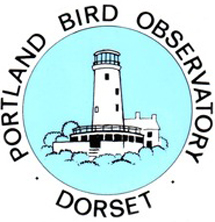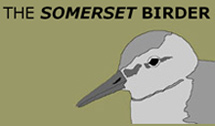Weekly round-up: 23 Dec 2014 - 06 Jan 2015
With a Ho! Ho! Ho! and yet another failed attempt at progressing past nothing other than a hail and hearty chorus of “Auld Lang Syne”, we return to the mundane world of rare birds in Britain and Ireland with a scoot through the last seven days of 2014 and the first six of 2015.
A typically lively festive period saw a fine array of post-Chrimbo dinner fayre on offer - spread far and wide around the assorted nation states that we bring within the all-enveloping arms of Round-Upsville and, as seems standard nowadays, there was always something to talk about and always something to see.
After the somewhat atypical meteorological lead-up to Christmas, where temperatures remained on the positive side of above the seasonal norm, the advance of the holidays saw things actual become far more in line with the seasonal norm - as cooler air from northern climes drifted in and out over much of the country through until New Year - bringing sunshine, rain, hail, sleet, snow, strong winds (from time to time) and a mix of degrees centigrade that was generally in the very low single figures (with a wind-chill that frequently dropped out of the black and in to the blue).
All that weathery-stuff aside, here we go then with the first RBA Round Up of 2015…
…and what a list of rares we have to go at!
The final embers of the birding year of 2014 have all glowed the most warming, soothing of glows from within the White Rose county - a county who’s emblem fittingly resembles the demure and delightful Christmas Rose, which is all rather apt given the wonderful mini-procession of really rare birds that have gifted themselves to many, including one bird that laid many listing demons to rest as a parting present as the grande finale to a hectic and frequently galling 12 months.
So, although not the rarest bird seen across the Christmas break, there’s no doubt where we have to start and that’s in the east of Yorkshire, a couple of miles from Bridlington where the birding fireworks where set off early thanks to the (twitchable!) appearance of…
Little Bustard!
The second within two months…!
Then, before you know it - the third! Within less than 24 hours!
Truly remarkable scenes.
After the general kerfuffle caused by the Mega Alert of December 30th and the then-disappeared Little Bustard in East Sussex - the more astute and less bleary-eyed amongst you will know there’s more on that one to follow - the news of a “probable” in flight not far from Bridlington during the early morning of New Year’s Eve would have gladdened the hearts of many (tho’ not perhaps any of those itinerant birders with a “LB” sized hole in their lists who were stationed down south, on the off chance of a reappearing act of the main attraction there…
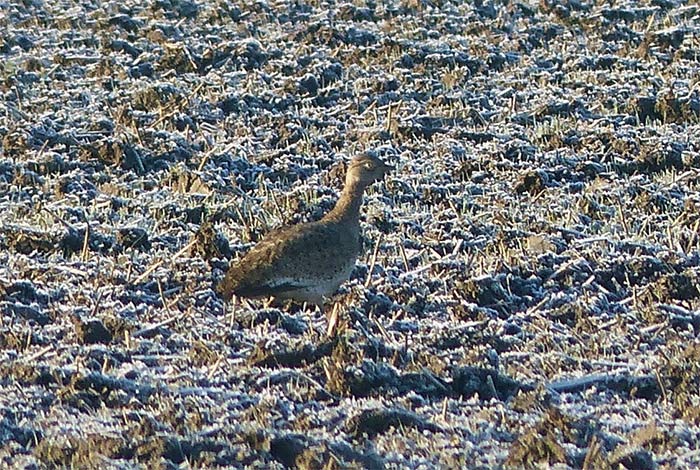
That “probable” news meant there was hope - and the reasonably hour which news was disseminated meant that those of a gambling persuasion would roll the dice and head towards Fraisthorpe. Just in case…
Before the clock struck noon for the final time in the outgoing year, it was firmed up and by dusk any number of birders had availed themselves of another choice rare from the School of 2014 - with spooky shades of the scenario mentioned a few weeks ago on these pages.
This superb find, a bird that spent a large amount of time within the confines of oil-seed rape and kale fields is the first for not only East Yorkshire, but the county as a whole since two birds were found within quick succession of each other in November 1956 - a young male being shot at Aldbrough on the 10th with an adult female shot ten days later, on 20th near Holderness in the East Riding of Yorkshire.
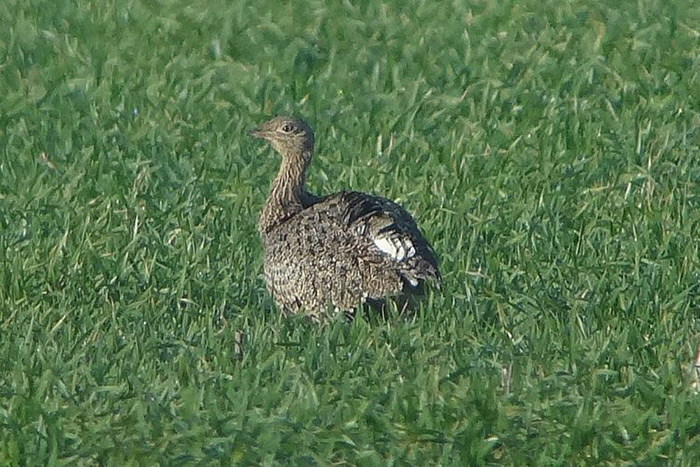
And for all those who couldn’t get there on New Year’s Eve, the first day of 2015 was a very happy one indeed, as the bustard duly obliged again and did the business throughout January 1st.
…and of, course perhaps the most remarkable thing about the New Year’s Eve discovery was that it came a matter of hours after the second Little Bustard within six weeks or so had been found some 280-odd miles due south of Yorkshire on December 30th.
Initially, the big question was whether the individual found at East Guideword Levels in East Sussex was perhaps the very same individual that was noted in Dorset on November 18th 2014 - with the way in which the story has unfolded since (backed up with photos for all in question) the answer seems to be an unequivocal “no”.
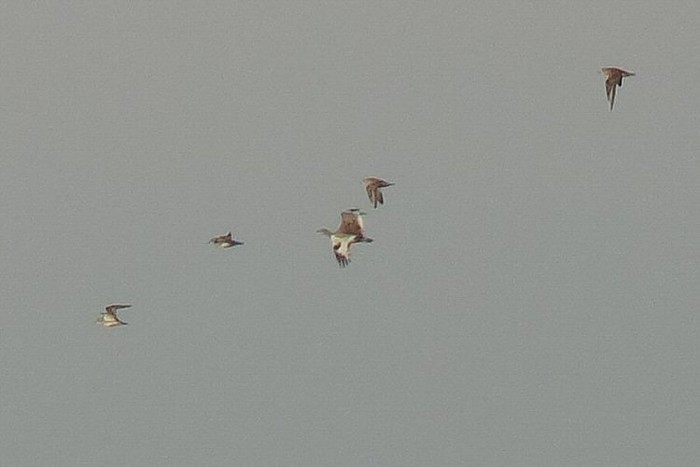
 ...so I shot upstairs to wake poor Reuben up. I quickly dressed him, grabbed my scope, bins, camera, etc, ran downstairs, grabbed a Christmas selection box for him to eat in the car for his breakfast, he didn't mind that, then drove to meet Kev...
...so I shot upstairs to wake poor Reuben up. I quickly dressed him, grabbed my scope, bins, camera, etc, ran downstairs, grabbed a Christmas selection box for him to eat in the car for his breakfast, he didn't mind that, then drove to meet Kev...
Read Tony Dixon's 're-finders' account here
The second south coast bird within a couple of months was seen at around 0930 on the morning of 30th, before heading strongly south and, once accepted by the Rarities Committee, will become the first record in either of the Sussex counties since one at Goring-by-Sea (in the West) on January 12th 1914. The East’s “most recent” bird was obtained near Willingdon on April 9th 1904 - the two counties share 11 records (excluding this one).
With cold weather scooting in from the continent, this pulsette of two birds should have given a winter shot-in-the-arm to intrepid fieldworkers everywhere (especially on the east coast…) - the trio of birds seen between November 18th and December 31st are now, if you remember, the first Little Bustards to be found here for over 12 years - the most recent one prior to that being the adult male seen on Scilly, on St. Agnes on March 22nd 2002.
Before that - as was mentioned six weeks or so ago, the three birds noted through the 1990’s were split 2:1 between Shetland and Cornwall - a female Little Bustard was seen on Mainland Shetland on October 4th-6th 1998 but was then injured and sadly died in care a couple of days after. A four-day bird around the Lizard in late October 1996 proved to be particularly popular - moving swiftly around the crop fields and stubble - while a male spent November 5th-6th 1994 on Fair Isle.
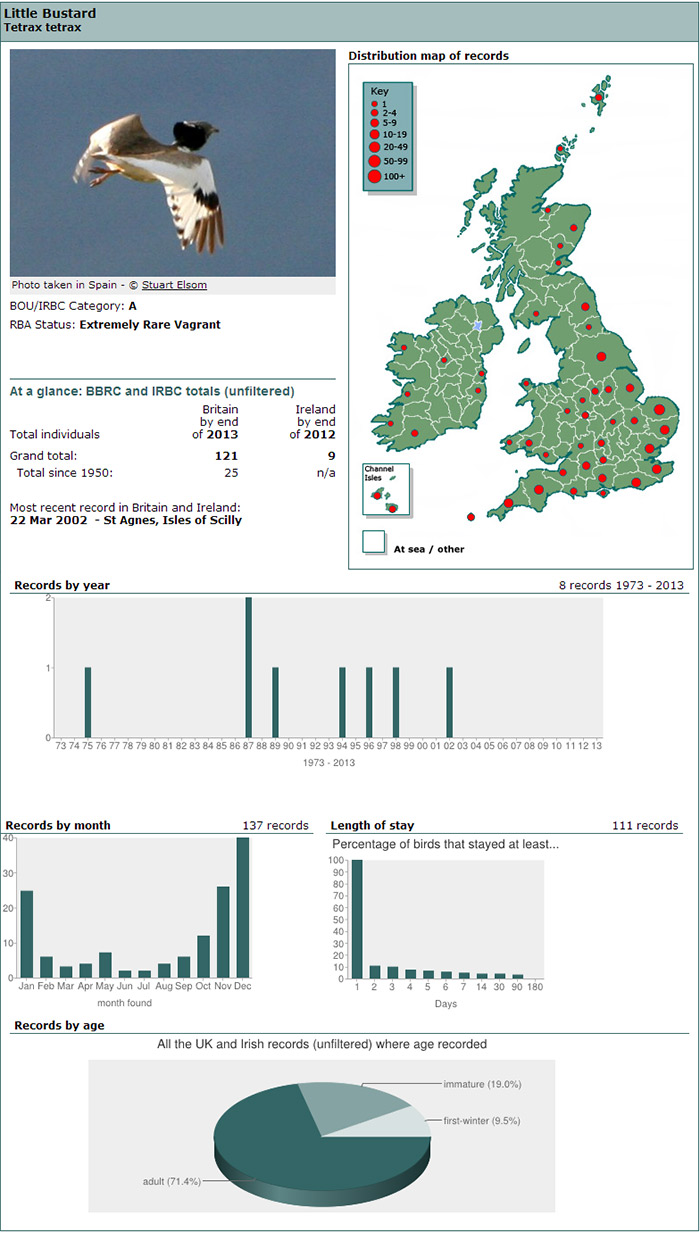
Orkney recorded a one-day male Little Bustard on North Ronaldsay in May 1989 and, before that, 1987 saw the remarkable arrival of three birds at Sudbourne (Suffolk) on December 20th, with the much twitched Dorset bird at Cowards Marsh - found, by one of those delightful, delicious quirks of fate on the very same date as this week’s Sussex bird, back in 1987 - obliterating many, many New Year celebrations when it was relocated at Sopley on New Year’s Eve (just like the Bridlington bird).
Déjà vu or what.
Meanwhile, in the west of the county…
Coming along as something of a post-Christmas surprise, particularly given the location, was the juvenile Thayer’s Gull that found a way to West Yorkshire, at Mirfield on 27th - seen briefly, but photographed, on the day of discovery, the bird returned to the same site, adjacent to a nearby landfill site on 28th where it showed well at times before relocating to the nearby main waterway at Pugney’s CP, where it performed from mid-afternoon to dusk, providing what could be a quite remarkable double-bill of rarities within such a short distance within a land-locked county.
The appearance of vagrant Thayer’s Gull is something of a moveable feast these days (and a hobby horse for some round these parts) - there are those that are closer to the “classic” text-book look of the juveniles in and around Cork and Cobh in February and March 1990 and Mayo in December 1998 to April 1999 (and this one isn’t too far from these…).
Giggity.
Others have been the cause of much identification debate, notable head-scratching birds such as the pale juvenile/first-winter at Barnatra in March 2005 and in and around Galway Bay in both January-February 2010 and February 2011.
Where does the West Yorkshire bird fit in the sliding scale of “niceness”?
A roof-top shot or two suggests that all seems well. Very well in fact. On the water…hmmmm…but the intense setting sun is surely at the root cause of the slight wariness elicited in some quarters…
Take a peek at the pix and see what conclusions you come to…
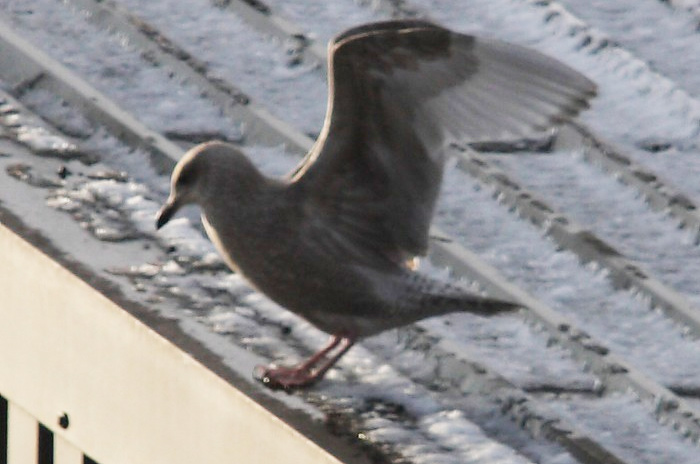
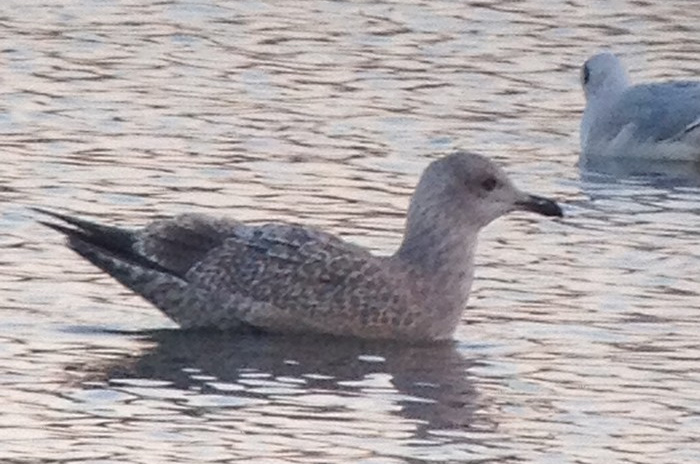
…and whatever those conclusions maybe, you and I and the gulling intelligentsia may vary markedly, it was one heck of a find.
 Fairly soon I noticed a bird that was structurally fairly similar to an Iceland Gull, it was a first winter bird and was sat looking straight at me. What struck me most was the solid colour of the breast; it was a coffee brown with no sign of speckling, too dark for an Iceland but perhaps an aberrant one?
Fairly soon I noticed a bird that was structurally fairly similar to an Iceland Gull, it was a first winter bird and was sat looking straight at me. What struck me most was the solid colour of the breast; it was a coffee brown with no sign of speckling, too dark for an Iceland but perhaps an aberrant one?
Read Jim Welford's finders account here
In Britain, the picture isn’t much clearer than that in Ireland in terms of what some of these things are - not at present at any rate, in “official” returns that is - Thayer’s Gull remains only a form of Iceland Gull (perhaps with good reason too) despite many other authors and birding associations regarding it as “good” and there’s still yet to be any acceptances here, despite at least two outstanding candidates being offered up.
The first of these is the (generally) fine-looking adult that spent a day on the tip at Pitsea in Essex on November 6th 2010, with the second coming to Lincolnshire in April 2012. Both of these seem destined to be accepted but will the often-discussed juvenile that was found in Oxfordshire, at Dix Pit in December 2007 and January 2008, relocating to Derbyshire’s Pools Brook a month later, sneak in ahead of them?
The current standings are that the Essex adult and Lincolnshire juvenile have made it past Base Camp and moved on to BOURC level, while the Oxfordshire bird and last year’s (seen between February and April) juvenile Thayer’s on Argyll (generally around Bruichladdich) both currently reside with BBRC.
No mention as yet of the well-twitched bird seen at Burry Holms (Glamorgan) in January 2014, but that too should fair well when it gets to the committee stage.
Sadly, as the workings on the tip began again, the gull seemed to take its leave of the area - no signs post Day 2, but that bird is surely going to surface again somewhere soon in the many gull-roosts of maybe Yorkshire or the Midlands as the firm favourites…
The second rarest species of the past two weeks in West Yorkshire was the sometimes obliging first-winter Blyth’s Pipit which continued to frequent the flooded rough meadows adjacent to the Pugney’s Country Park through to 6th ~ the BP at the PCP edging past the departure date of the Gringley Carr in January 2003 by at least one day....
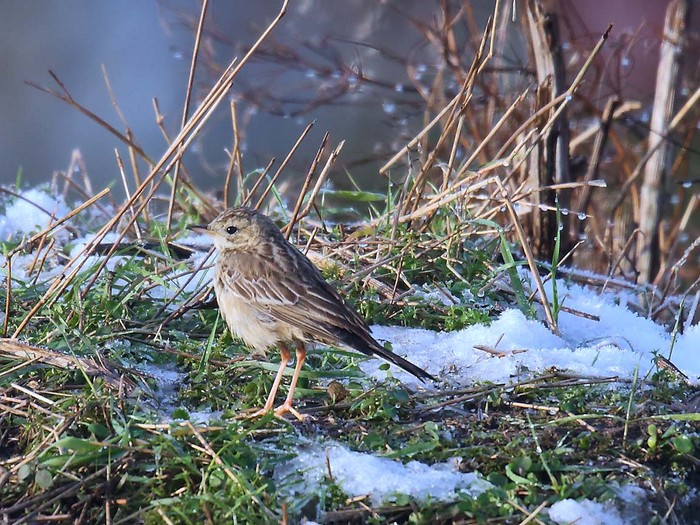
This county first (for the whole of Yorkshire, not just the west…) remains one of the finds of 2014 ~ given the time of year and the location chosen by the bird ~ and many hundreds have travelled towards the site, within a hefty stone’s throw of the main motorway routes, and pretty much everyone has left happy.
Found on December 8th, the bird has clocked up a stay of 30 days to date, a tally that eases it in to third place in the “long stay” records book ~ just two of the other 23 Blyth’s Pipit seen to date (a figure which includes the photographed individuals on Scilly and in Pembrokeshire last autumn) have stayed longer ~ the Seasalter bird of November and December 1994 managing 35 away days in Kent, with one around Land’s End for 36 days in November and December 2004.
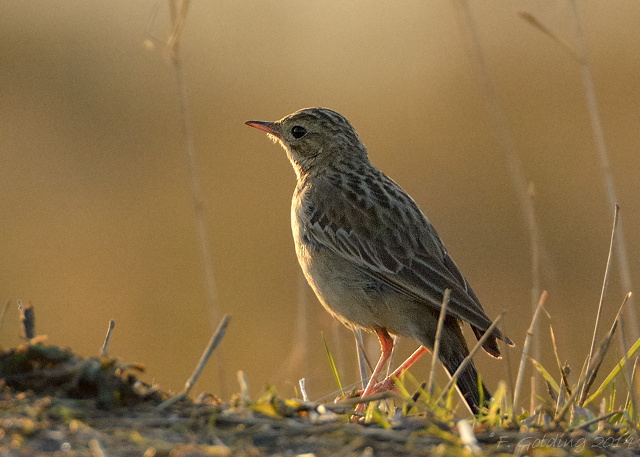
(Clearly these long-stayers only ever come when there’s a year ending in 4…so maybe 2024 is next…).
That 14 of the 24 British Blyth’s Pipit records to date (Irish birders still await their first) have occurred since the turn of the 2000’s is perhaps testament to a genuine increased observer awareness, perhaps more so than a westward push by the species in question.
Yes, they may have nudged “this way” a bit, but most of the upward spike in records must surely come from birders understanding, better than ever, the subtleties of this tough-to-call species. It makes the efforts of those involved with the first modern records, on Fair Isle in 1988 and at Skewjack, Cornwall in 1990 all the more admirable too.
The finite detail and prolonged fieldwork study that is often required to get yourself a nailed-on Thayer’s Gull or Blyth’s Pipit doesn’t really come in to play (in any shape or form) when you find yourself in that delicious “right place, right time” moment that leads to the discovery of a super-spotty baby Ivory Gull.
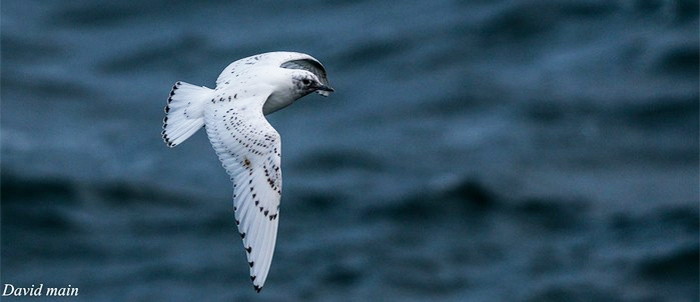
A couple of weeks ago, one of these eternal beauties from the High Arctic took a five day trip around the central area of the Outer Hebrides chain, moving from site to site around Benbecula between December 13th-18th - the latter date seeing the bird in question enjoying an ample supply of fresh(-ish) sashimi courtesy of the recently deceased Cuvier’s Beaked Whale on the beach at Borgh.
Whether the same young bird had taken a flight across An Cuan Canach - the Lower Minch - that separates the southern-most islands of the Outer Hebridean chain and Skye was something that we could only speculate upon (oooooooooh, we love a good speculate here…) but the finding of a juvenile Ivory Gull in the harbour at Uig, in the north-northwest corner of Skye on 23rd appeared, at first glance, to be more than just a coincidence.
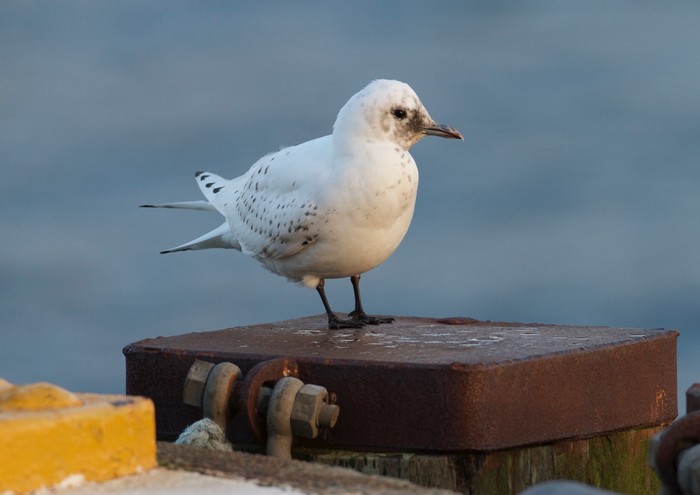
The bird was seen once in the morning and then again later in the afternoon of 23rd from on board the ferry to Lochmaddy (someone’s having a fine old time of it off that boat at the mo., coming hot-on-the-heels of the recent Brünnich’s Guillemot from the same vessel) but no further reports came forth until it reappeared in, pretty much the same place, on the afternoon of 28th.
The spotty herbert lingered there through the following day too, heading out to sea for a while on a creel boat on 29th - and that was the day when the evidence came forth that this was certainly a different individual to the Hebs., juvenile - the Uig bird less intensely dark around the face and with slightly-less boldly spotted upperparts and wings. The bird remained faithful to the pier area through to 4th and was as tame as you like.
To date, it appears as though this may be only the second record for Skye, the only other to date being one at Broadford Bay sometime in February 1901 (when the island was still in Inverness-shire, rather than the all-encompassing Highland it finds itself in now) - the latter region having a grand total of 17 acceptances up until the end of 2013 (a year which saw two recorded in December, at Tarbet Ness on 5th and Droman Pier on 18th).
Despite the lingering tag of “extreme rarity” that hangs around the downy-ducky neck of the always delightful Harlequin it takes a slightly lower place in the running order of the past fortnight’s rarity runner’s and riders as it was only just over a year ago that another bite at the cherry came along and, hey, there’s an editorial flow to think of right?!?
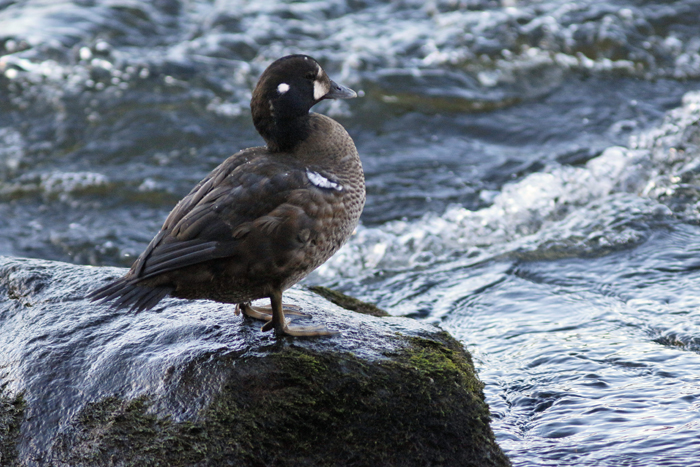
Slightly precious editorial flow or not, the news of the super first-winter drake Harlequin on the River Don in and around the outskirts of Aberdeen ensured the second big draw of 2015 - with just four days on the calendar.
Initially seen on 3rd, the arrival became news on 4th and although the gatherings across the following two days may not have matched those that currently head to see the SPL table-toppers at Pittodrie there were enough folk there to draw a bit of local media interest in to the bargain.

This will become the not just the first record for Aberdeenshire, it also becomes the first for northeast Scotland too. It is also the first male mainland Harlequin since a pair arrived at Wick in April 1965 (having earlier spent some while on Fair Isle) - a female was noted at the same spot for over three months from February 1991.
The Granite City’s new rarity is also the first mainland record of this particularly alluring vagrant since the two young females spent 15 days on the coast of Ayrshire, at Girvan, in April 1996 but it was only in the middle of February 2013 that we saw the appearance of another twitchable Harlequin - the popular first-winter drake that was discovered near the Balranald RSPB reserve on North Uist, on the Outer Hebrides on February 18th, a bird which lingered to June 1st.
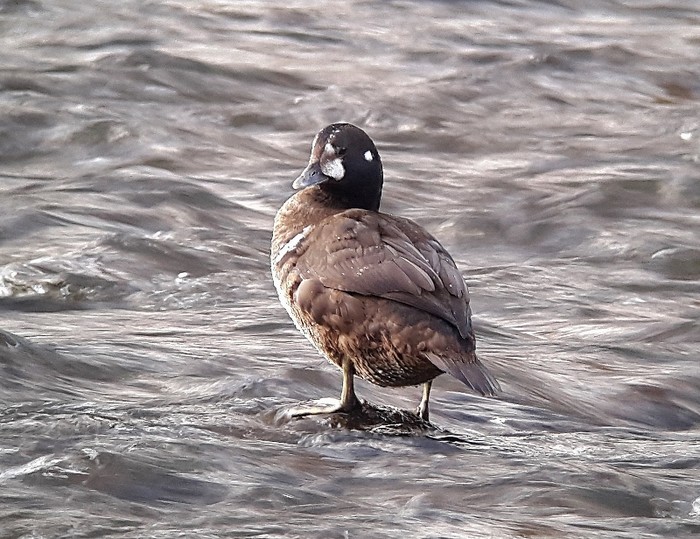
So, despite there being just 16 records (up to and including this newbie) there have been two chances to have a go for this still-mega duck in the past 13 months.
Some 700 miles to the southwest of the starkly beautiful Granite City is the equally beautiful St. Mary’s on Scilly and we alight here momentarily to report upon the continuing presence of the delightful first-winter male Eastern Black Redstart that remained at the Shark’s Pit, between the beaches of Porthloo and Porth Mellon to 6th.
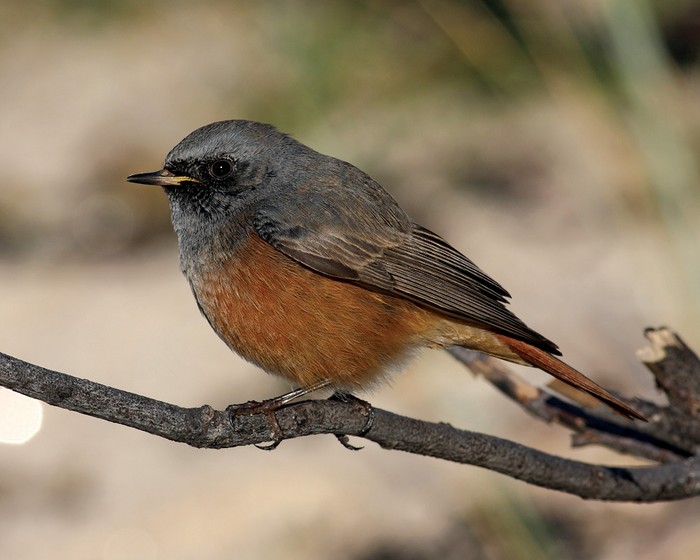
All of the recent examples of this markedly different form (in Kent, Northumberland, North Yorkshire and this one on Scilly) show just how stonking the males of the species-in-waiting really are (Tien Shan Redstart does have a certain mystical appeal…) ~ but the first female from the backwaters of Central Asia has yet to be unravelled by anyone here.
Now there’s a challenge…
…and talking of challenges…
We’ve already had Blyth’s Pipit and whilst we’re still in the ever-lovely far southwest of England, there’s time to mention the continuing presence of another bird that, not so long ago, was a true test of the I.D. capabilities of many - Pacific Diver.
Thanks, in no small part to the continuing desire to return back to Mount’s Bay, the Cornish Pacific Diver has aided and abetted many in their quest for knowledge of this relatively-recent split (September 2008, in-litt, early the following year).
The bird has proved typically tough-to-see, reported on eight dates through the whole of December, the most recent of those coming on 28th with the bird still in situ to 6th. It’ll be interesting to see how the proposed trip out in to Mount’s Bay in a couple of weeks time gets on in terms of tracking down this exceptional rare.
Whilst still being a hugely rare bird in real terms, there’s really not a lot left to say about the American Coots on Kerry’s Lough Gill and North Uist’s Loch nam Feithean, on the Balarnald RSPB reserve other than, several weeks on from their respective arrivals both were still present through much of the holiday period, to 4th and 6th respectively ~ the odds remain high on departures in early April.
…and finally…
Being the season of Goodwill and all that, it felt as though the time was right to extend a late, and somewhat benevolent “Season’s Greetings” hand-of-friendship towards a couple of species that, although featuring low down on the discerning birder’s “wants list”, did generate more visitors over Chrimbo time than many of the more typical rares that remained up for grabs as one year departed and another arrived…
The pair of Trumpeter Swans which continued to enjoy the herbage of Boyton Marshes RSPB (Suffolk) were, obviously, unaware of the interest that they gradually began to attract as the hols approached - drawing a trickle of insurance listers and the curious (also insurance listers, they just won’t admit it…) to this pretty part of Suffolk, just southwest of Aldeburgh, to 6th - a date which, for the reason that follows, will be their last appearance here…
Before the question of the origin of these two was solved, the possible avenues of discussion have been explored elsewhere - with the likelihood of vagrancy being batted back and forth ‘til the cows come home. It was always highly unlikely (and that’s being generous) that this once-critically endangered species would find a place on the British List (on Category A at any rate) courtesy of this pair of (at first) intriguing individuals but it made a day out and a break from the norm, so, for the desperados and onlookers, well fair enough I suppose.
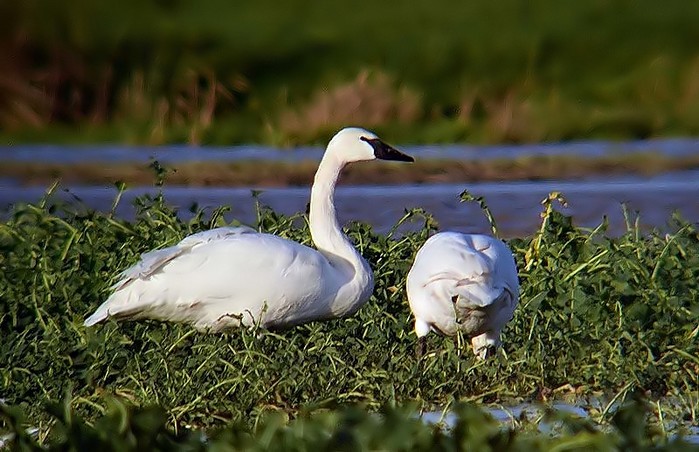
(It is, after all, a better way to spend a day than watching another old episode of “Bait Car”, the unfathomable “Dog & Beth On the Hunt” or “Cops” on CBS Reality - there’s only so many times you can cope with another methamphetamine-fuelled car chases with crack whores, unspeakably dumb “heists” or a ridiculous old man with shocking golden-tousled hair not really knowing what the feck is going on around him...).
Just as the round-up was being drawn to an end, out popped news that, finally, these roaming rogues origins had finally been traced - and in news that would surprise precisely no-one it turned out they’d come on a flight of not the few thousand miles some had hoped, but something closer to just under eight…wire-hopping, lock-up breakout merchants from Wickham Market rather than Transatlantic vagrants it was then.
…whether the same short hop also applies to the equally-debated and (presumably) equally-unlikely Category A candidate, the juvenile/first-winter American White Ibis is something we still don’t know, but despite it continuing to feel at home at the Sevenoaks Wildfowl Reserve (Kent) through to 30th, there’s been not a sniff of news since then ~ indeed there was actual “negative news” on 6th....
Much of the online heat that was being generated by the whys and wherefores of the merits (or otherwise) of the likelihood of vagrancy has been batted back and forth ‘til the cows come home (the same level of “duffness” requires nothing more than the same milking-parlour analogy as the plastic-fantastics).
Actually, much of the heat on this critter began to dissipate once the black-billed beauts above loomed in to view, but a few people continued to invest their hard-earneds in a little day out. If it rings your bell, well, that’s cool I guess.
Ahhh, the spirit of peace, love and harmony appears to have broken out.
It won’t last.
No doubting the pick of the bunch over the past two weeks - the Seabird of the Holidays award goes to the White-billed Diver that flew over the pier at Ballycotton (Co. Cork) on 30th - the database shows three accepted records for the county to date (in February 1974, May 2004 and October in to November 2008) but there have been more records reported…
Meanwhile on Orkney, an old favourite was back in the waters of South Ronaldsay on 2nd - the long-returning White-billed Diver on station once more after its first appearance on the general area of St. Margaret’s Hope in the summer of 2008. It remained to 4th at least.
Ten Christmas Day Little Auks made their way north past Northumberland’s Beadnell Point (with one there on 27th and another at Seahouses on 28th) while in Durham, Whitburn birders managed a single on 26th, three on 27th and nine on 28th. Further north, a single bird was noted at sea between Cromarty and South Sutor on 26th and with more noted off Musselburgh and Gullane Point (Lothian) and Kinghorn (Fife) on 28th, while a high count of 17 Little Auks came from Torness (Lothian) on 27th.
Further random singles and very low numbers were seen in Scotland through to New Year with one in Cleveland, off the headland at Hartlepool, on 1st, a day when five were seen from a boat in Lunan Bay (Angus) with two there the following day.
All the totals above were then beaten by a one-off tally off 55 past Culbin Bar (Moray) on 4th.
As Christmas drifted ever-closer to, and on into, New Year, some 40 Pomarine Skuas had been logged, all bar three along the east coast, including two off Kirkcaldy (Fife) on 23rd and two in 40 minutes off Cley (Norfolk) on 25th. The west coast saw two Welsh singles noted lingering in Rhossili Bay (Glamorgan) on 24th and off Ramsey Island (Pembrokeshire) on 27th and the English Channel coasts of Devon saw one noted off Broadsands on 28th with two off Start Point on 31st and one off Dawlish Warren on 1st, with lone birds off Pendennis, Falmouth (Cornwall), Portland Bill (Dorset) and Rustington (West Sussex) the same day. Further singles were dotted around assorted coasts, from Shetland down to Suffolk and Dorset, to 6th.

A Grey Phalarope that appeared on a flooded meadow just south of Filby (Norfolk) on 22nd was present to just after 10am on 23rd when it was taken by a local Sparrowhawk while faring better were the two birds in Licannor Bay (Co. Clare) on January 2nd, and the two that headed past Pendeen Watch (Cornwall) along with four Balearic Shearwaters the same day. Two more single Grey Phalaropes round things off - one was seen on the Wirral, at Seacombe on 4th-5th and another was at Inverallochy (Aberdeenshire) on 5th.
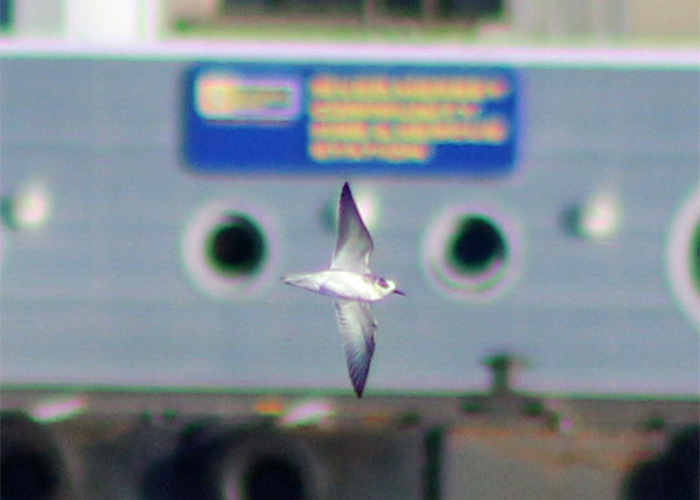
Three Cattle Egrets made themselves known across much of the Festive Period and it will come as little or no surprise that they comprised of two at Dungeness and one at Frodsham, the former duo in place to January 6th.
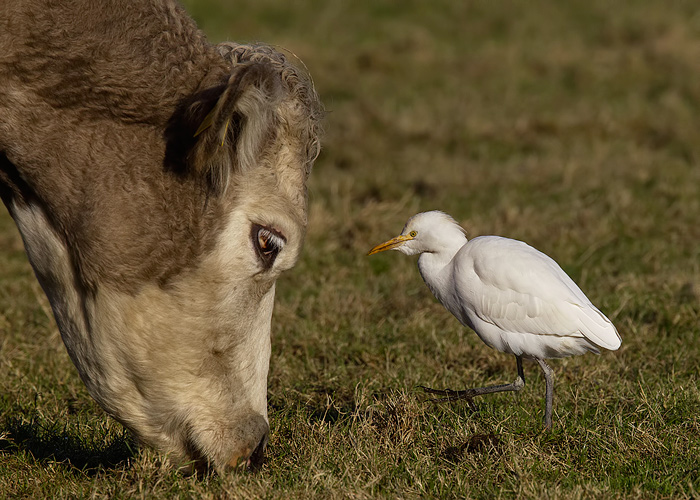
Up to 45 Great White Egrets had been up for grabs by the close of 6th - spread widely across England and Wales, with actual numbers rather tricky to assimilate.
In northwest England, there were two for Lancashire (at Crossens Marsh on 28th-29th) and at least three remained in Cheshire, one at Frodsham and two at both Burton Marsh Wetlands RSPB and Parkgate Marshes to 28th at least. A single Great White Egret was noted in the northeast, at Thorne Moors NNR (South Yorkshire) on 30th and another was noted at Deeping Lakes LWT (Lincolnshire) on 2nd.
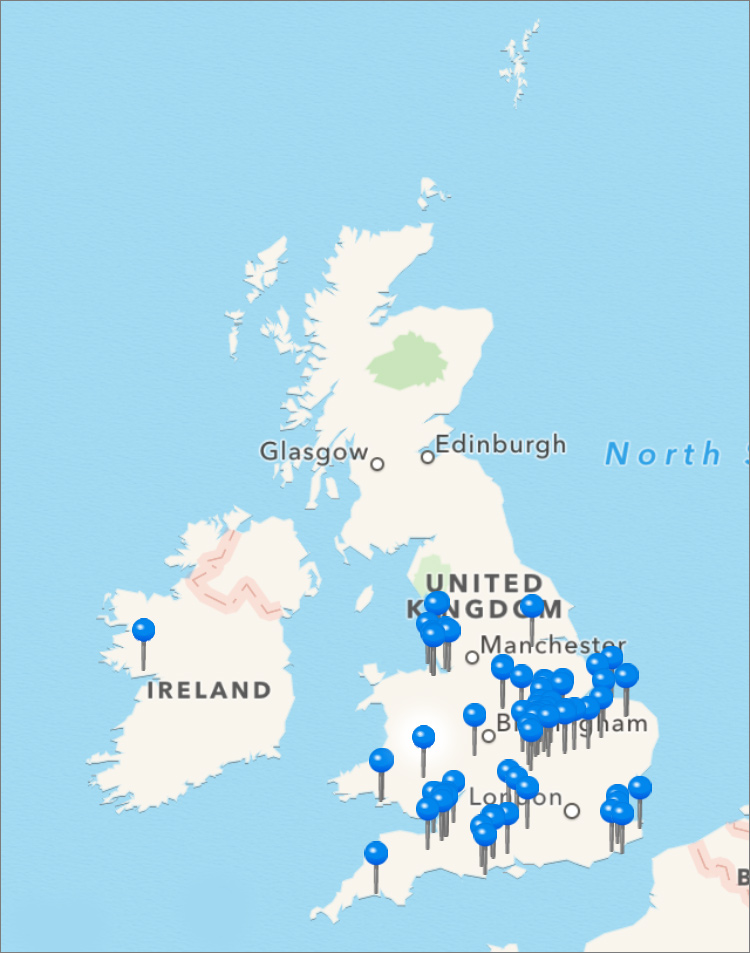
In the Midlands, two remained at Rutland Water (Leicestershire) with another at Eyebrook Reservoir on 5th while two were at Willington GPs (Derbyshire) on 1st and a maybe half a dozen were seen in Northamptonshire.
Talking of which, Pitsford Reservoir has rightly been moved back in place in Northamptonshire - my erstwhile colleague from Da North momentarily placing the site a little further east last time out (that’ll teach him, pina coladas my arse…ice-cold “Antarctica” at skanky Rio beach bars was more my thing…) - and to celebrate, let’s report news of two Great White Egrets present there at Pitsford on 26th after two were at Ditchford on 24th (with others at Summer Leys - three seen on 2nd -, Thrapston, Thorpe Maisor Reservoir - two there on 31st - Billing Aquadrome and Silverstone through to 5th).
In East Anglia, singletons in Cambridgeshire were seen at Fen Drayton RSPB on 25th, along the Cam Washes on 28th and Fen Drayton RSPB on 29th-1st; two were on the Suffolk/Norfolk border at Lakenheath Fen RSPB on 26th and single birds in Norfolk “proper” were at Sparham Pools from 23rd-6th, in the Nar Valley, also on 23rd and then Snettisham RSPB on 28th and Burnham Overy on 1st.
New Home Counties birds were at Great Shefford and also Harrold and Odell CP on 30th (the latter of which presumably then moved to Foxcote Reservoir in Buckinghamshire on 31st) while up to five remained at Dungeness RSPB to 5th and two were over the border at Rye Harbour (East Sussex) on the same date, while hopping west, one remained around Blashford Lakes HWT (Hampshire) to 31st at least, with one also at the Lower Test Marshes on 28th.
Another hop west takes us to Dorset, where a Great White Egret was again at Studland on 23rd and 28th-5th (albeit infrequently reported) while in Somerset, birds were reported from at least five sites, including four together at Ham Wall RSPB on 24th and three each for Shapwick and Meare Heath on 30th.
Welsh birds included perhaps as many as three at Llangorse Lake (Powys) at the start of the review period (with one still on New Year’s Day with the trio again on 5th) and two more were also noted at Llanrhidian Marsh (Glamorgan) on 24th and 28th, with presumably the same two noted at Wernffrwd on 27th.
December 27th saw the first sightings of Glossy Ibis for a fortnight or more - seen at Fen Drayton RSPB (one was last reported from here on November 30th) and also at South Huish Marsh in south Devon. The latter bird remained to 3rd, the former to 2nd. Ireland’s wintering bird was noted again at Tramore Backstrand (Co. Waterford) from 2nd.
The Spoonbills noted through the holidays included three remaining in West Sussex, at Church Norton and Snow Hill Marsh through to beyond the New Year with three on north Devon’s Taw Estuary on 1st.Two were at Holes Bay (Dorset) and Dungarvan (Co. Waterford) on 27th (seven were counted at the former site on 28th, with 21 counted there on 30th and an impressive 31 on 2nd) with further duos at Suffolk’s Havergate Island on 1st and Cornwall’s St. John’s Lake on 2nd, with three at the not-too-far-away Wacker Quay to 6th.
Single Spoonbills were on Scilly, still around Samson, Green Island and Bryher for several days to Christmas Day and beyond, with the wintering adult at Cromane (Co. Kerry) to 27th too.
The Stubb Mill Common Crane Broadland roost yielded 25 birds on 26th with eight near Acle on Christmas Eve. The first days of January then produced a high count of 31 at Upton Broad NWT on 4th (the site is around five miles from Hickling as the Grus grus flies). In Cambridgeshire, two were seen again on the Nene Washes, at Eldernell, on 25th and 30th, with a double at Wicken Fen NT on 29th.
Finally, December 30th brought news of an unseasonal juvenile Night Heron -roosting in scrub at Burnham-on-Crouch, it was seen to head off towards Wallasea Island RSPB later in the day. Also something of a surprise was news of an adult Night Heron in Norfolk’s Wensum Valley, at Sparham Pools on 4th-5th - it has been some while since birds were thought to still be at large from the mob of free-flying individuals at Great Witchingham - but it feels appropriate to perhaps pop an “O.U.O” on this one, for now at least.
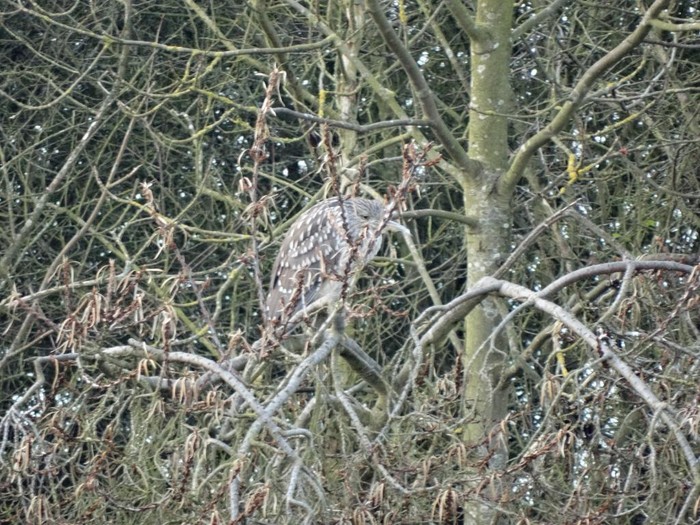
As was the case with the final review of 2014, the first of 2015 brings news of not one, not two, but three lovely forms of the white-cheeked goose complex - interior, hutchinsii and parvipes.
Starting off in Lancashire where the pair of Todd’s Canada Geese remained at their new chosen locality of Fleetwood to 24th at least and still amongst the wintering Pink-footed Geese. By 30th, they’d relocated to the goose fields near Knott End-on-Sea. Where next I wonder?
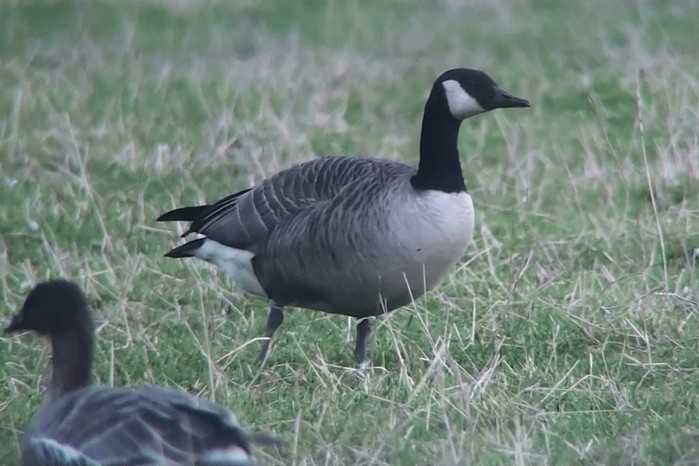
Interestingly, it does look as though these are a different pair of vagrant Canada Geese to that present at Lynn Point in Norfolk on November 16th, those birds thought to be most likely hutchinsii or parvipes, depending on who is interpreting the same set of images.
On the Outer Hebrides, a Richardson’s Cackling Goose was still at Baleshare on North Uist to 29th and another remained on Islay to 6th, whilst the wintering Irish Lesser Canada Goose was on Wexford’s North Slob to 4th (though there appears to be a train of thought to suggest this may be an interior after all).
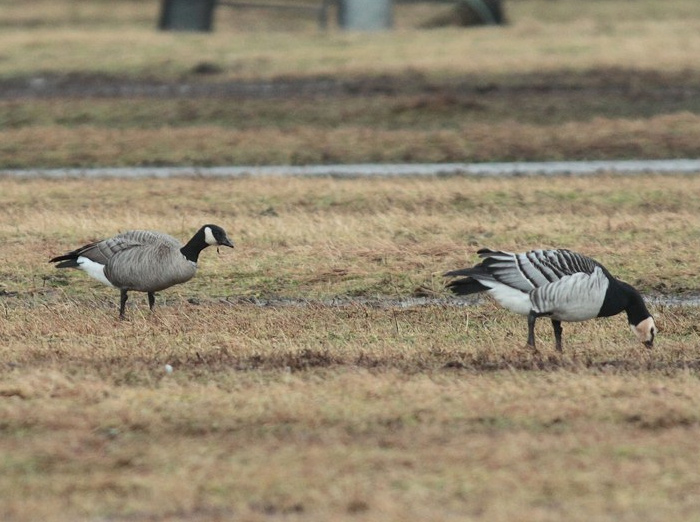

The first of two Snow Geese of the fortnight just gone was present on Mainland Orkney, at Holm, with the wintering Greylag Geese on 23rd with the second sighting coming from Cley, where the recent Lesser Snow Geese was reported heading west over the marsh on the morning of 4th ~ the first sighting since December 14th when it was down in the Broads. Where’s it been and where was it going? With no subsequent sightings in the north Norfolk goose hotspots, the tail has gone cold again. Maybe it has already crossed the Pennines and gone towards Lancashire where the presumed escaped Ross’s Goose remained at Marshside RSPB to 26th.
In Suffolk, a significant event for many locals was the impressive arrival of a quartet of colour-ringed Lesser White-fronted Gesse at North Warren RSPB (Suffolk) on 31st - one of the four was a satellite-tagged bird from a Swedish re-introduction programme that was noted in Norway on Christmas Day and then at Minsmere on 30th...the quartet roamed Suffolk’s marshes to 3rd before apparently splitting up - at least one heading to Belgium while two were at North Wareen RSPB on 5th.
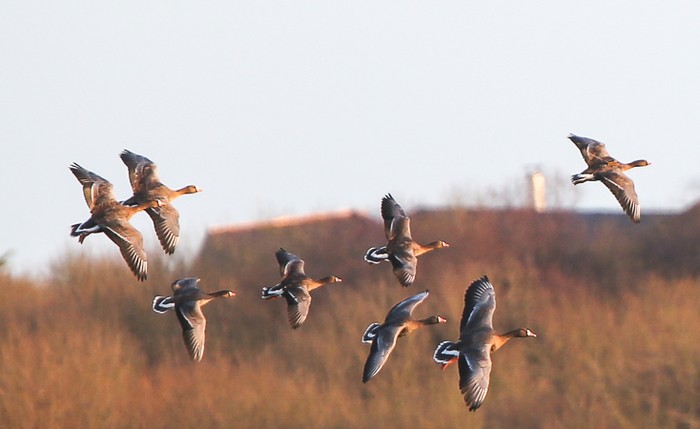
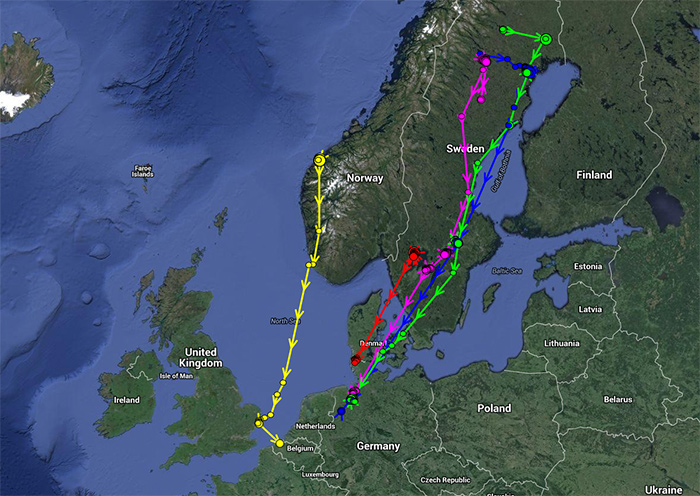
Black Brants from south to north (for a change) were logged at Darts Farm RSPB, Topsham and nearby Exe Estuary (Devon) on 23rd-4th; near Wyke Regis (Dorset) on 24th and at Ferrybridge on 4th; at Farlington Marshes (Hampshire) on 30th; Levington Creek (Suffolk) on 24th and at nearby Loompit Lake on 31st and Trimley Marshes on 1st-4th; around Cley and Salthouse (Norfolk) for much of the fortnight; in Lincolnshire, at Grainthorpe Haven on 24th and then nearby Donna Nook on 26th-2nd, still in East Yorkshire, at Kilnsea and Sammy’s Point to 6th and in County Kerry, one was found at Kilshannig on 2nd. Top of the three though, the three Black Brants at Dengie (Essex) on 1st.
With a good three weeks between sightings, there was news on 27th of the continuing presence of the wintering female King Eider at Ruddons Point, in Largo Bay (Fife) while the male was noted again off Burghead (Moray) on 28th - the first report since the early November.
Surf Scoters including a duo of drakes in Colwyn Bay (Conwy) on Christmas Day (rising to six by 28th and seven on 30th, including a female), the adult drake still off the River Esk, at Mussleburgh (Lothian) to 4th and the young drake present at Stutton Ness/Wrabness (Suffolk/Essex) to 6th. New was a singleton off Newcastle (Co. Down) on 2nd.
”He Who Wears The Saddle” remained at Llangorse Lake (Powys) to New Year’s Day at least and the second Welsh adult drake Lesser Scaup was all present and correct in Cardiff Bay through to 6th. The two Scottish representatives may not be quite what they seemed - the adult drake at Linlithgow Loch (Lothian) generated a fair amount of comment re:- its precise genetic make-up and purity, while the first-winter drake at Trabboch Loch (Ayrshire) also saw questions asked as to parentage. The former was in place to 24th, the latter to 6th. Further Celtic records came from Kerry’s Lough Gill where the wintering drake remained to 2nd and Galway’s Rahashane Turlough, where a female was found on 3rd.
Another returning Lesser Scaup made its way back to Dozmary Pool (Cornwall) on 27th and remained in the area to 6th - this is the same bird that was first seen here in April 2008 and has been noted annually in the area from 2010-2014.
The drake Ring-necked Duck at Bray (Berkshire) that was found on 22nd was last seen on 24th, appearing a couple of miles away at Jubilee River NR on 28th before flip-flopping between Bray and the Jubilee River from 29th - the first for the county in over seven years, since a female was noted at Slough in April 2007 - while in Northamptonshire, the female was relocated at Billing Aquadrome on 24th, remaining on the nearby pits a Clifford Hill GPs to 31st with a return to the Aquadrome on NYD through to 6th (it is presumably the same bird that was last seen on November 16th near Kettering).
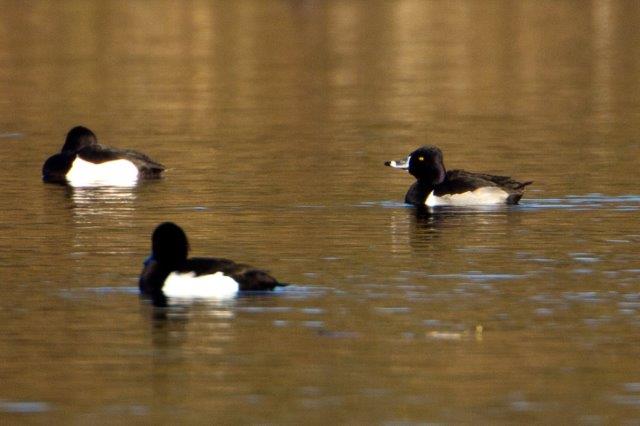
In Scotland, the pair of female Ring-necked Ducks stayed at Carlingwark Loch (Dumfries & Galloway) to 4th and the female was again on Loch Sandary, North Uist (Outer Hebrides) through to 2nd. The young wintering drake also remained on Tiree, at Loch a’Phuill, to 6th.
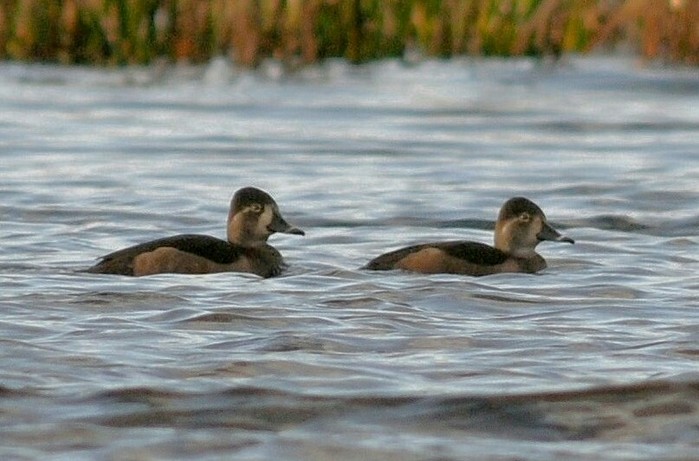
Irish birds noted through the last fortnight were lone drakes on Lough Beg (Co. Derry) on 24th, Knockaderry Reservoir (Co. Waterford) on 28th-3rd and Lough Shivnagh (Co. Donegal) on 3rd but, best of all, was the flock of four Ring-necked Ducks (three drakes and a duck) at Ross Castle, near Killarney (Co. Kerry) on 2nd.
A new female Ferruginous Duck appeared on the South Lake at Slimbridge WWT (Gloucestershire) on 29th - potentially the first in the county since a presumed wild female was noted on the same lake in March 2002. This year’s offering remained, off-and-on, to 3rd. Hampshire’s drake was still present at Blashford Lakes HWT also through to the same date.
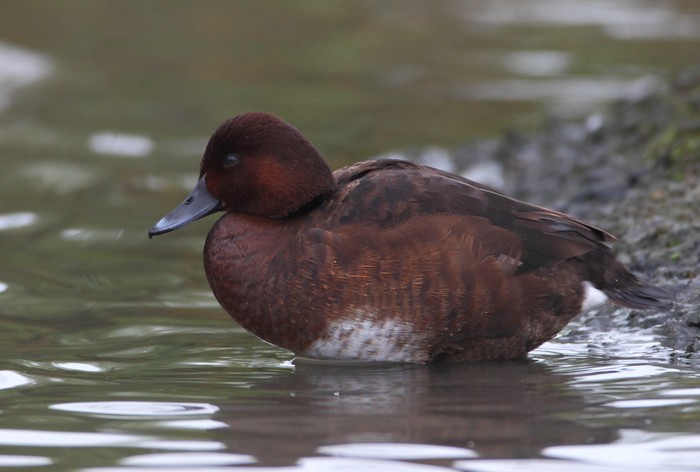
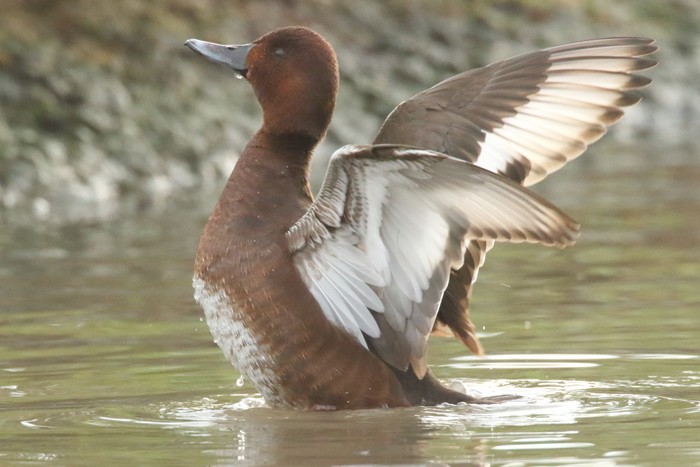
For almost the whole of the first week of the holidays, the only Green-winged Teal logged was the wintering drake that remained at Caerlaverock (Dumfries & Galloway) to 28th, the second bird appearing on 27th at Welney WWT (Norfolk) with the third being noted again at Loch Sandary, North Uist on 28th-2nd with the fourth coming to Ballycarry (Co. Antrim) on 29th-30th. Bird five was found at Brand’s Bay (Dorset) on 31st and bird six and seven followed the following day at Northwick Warth (Gloucestershire) and Cliffe Pools RSPB (Kent). The eighth of the fortnight was discovered lurking on Saltholme Pools RSPB (Cleveland) on 2nd and number nine followed the following day at Druridge Pools (Northumberland).
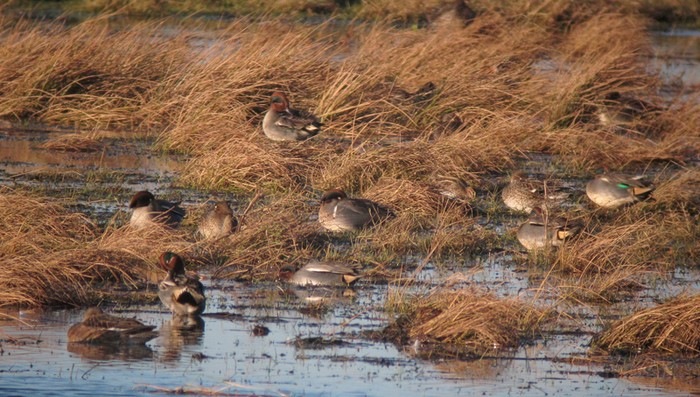
Back on North Uist, a drake American Wigeon was seen at Loch Mhic Coan on 24th-29th - moving to Crogary Mor on 3rd - with further drakes noted at Harper’s Island, Cork Harbour on 28th-4th, on Orkney, at Mill Dam, Shapinsay on 30th, still on Mainland Shetland, at Loch of Collaster, near Norby to 30th, at Malin Town (Co. Donegal) from 31st and again at Yelland Marsh (Devon) and also on Meikle Loch (Aberdeenshire) on 1st. In Cornwall, a single female remained on the Gannel Estuary (Cornwall) to 27th with two there again on 29th-3rd, with one through to 6th.
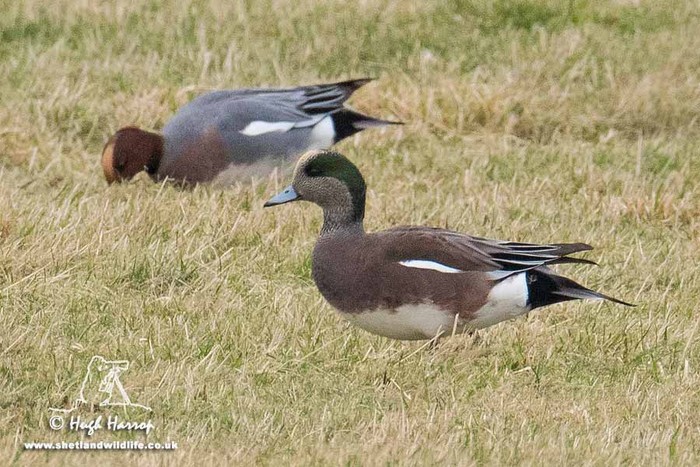
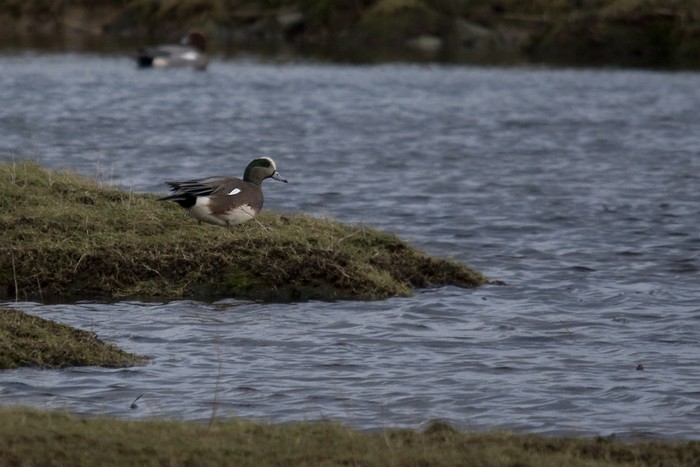
Something of a shorebird surprise came along to County Antrim on Boxing Day, when a White-rumped Sandpiper seen at Jordanstown, on the edge of Lough Neagh - the first anywhere since a late October juvenile at the Butt of Lewis, but the second for the Lough this year, one was present in mid-September.
A further suprise was news of a Long-billed Dowitcher in Wexford, seen around Tacumshin with Black-tailed Godwits on 2nd - a record that mirrors one from January 2013, the same species amongst its regualr travelling companions at Lady’s Island Lake, a bird which everntually moved to Tacumshin in March of the same year.
Aberdeenshire’s first-ever Spotted Sandpiper continued to winter at Inverallochy, noted there to 4th. Having arrived on October 19th, it seems as though only hard weather will curtail the stay now.
New for Christmas was a Lesser Yellowlegs on the pools at Pett Level (East Sussex), found on 25th and showing to 30th - three days later it was relocated at Rye Harbour NR where it hung out to 4th when it thought better of it and ‘legged it back to Pett Levels, where it stayed to the end of the fortnight. The combined accepted total for the two counties of Sussex is, currently, 10 - with an even split five for the West and five for the East, but this new arrival sees the East take the lead by one...
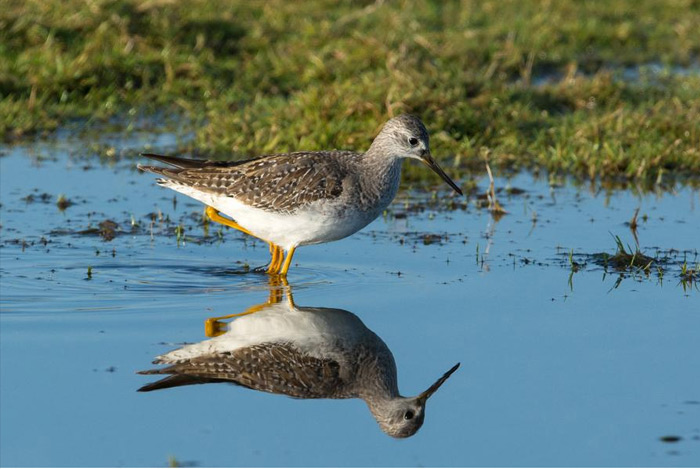
The first Lesser Yellowlegs in East Sussex was found at Cuckmere Haven in August 1970, with the second following at Weir Wood Reservoir just over ayear later, in September 1971. A gap of 12 years followed until a popular wintering bird arrived in Eastbourne in November 1983, with the fourth (and first for Pett level) coming along for a day in August 1988. The county’s most recent bird prior to this week’s new bird was seen at Cuckmere Haven in September and October 1998.
The second new Lesser Yellowlegs of the Chrimbo season was found on the beach at North Berwick (Lothian) on New Year’s Day and it was still present on 3rd. This will become the county’s fifth record and the first since one spent almost six months at Aberlady Bay from July to December 2009.
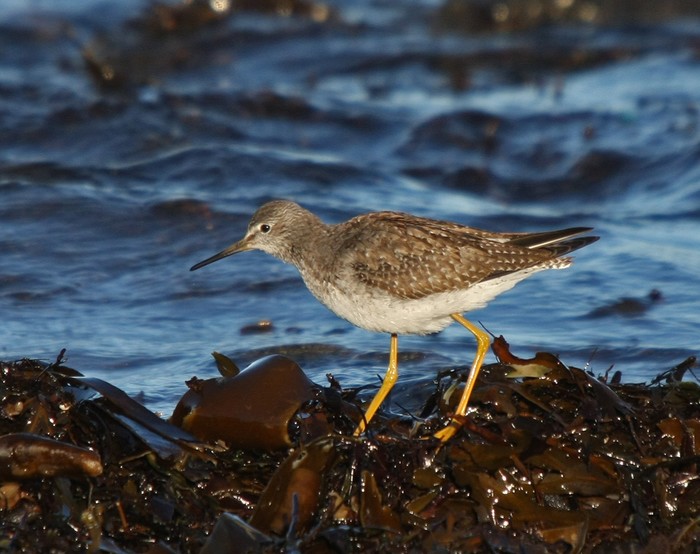
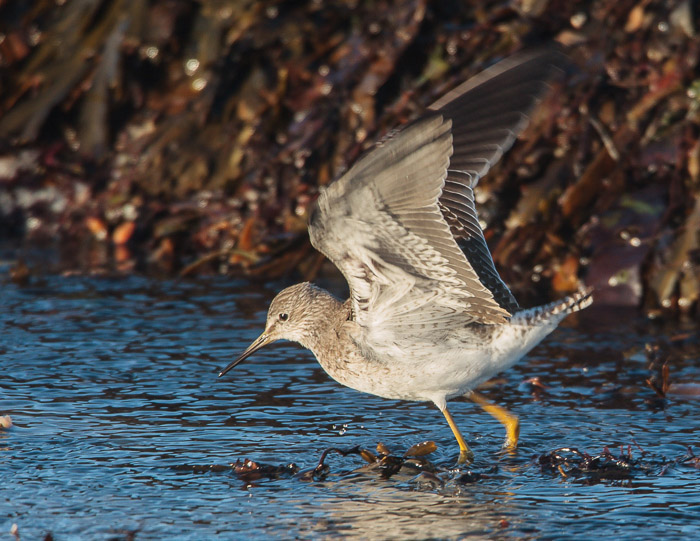
Over in Ireland, the wintering Lesser Yellowlegs remained on the Rogerstown Estuary (Co. Dublin) to 2nd and, popping in to the news for the first time since November 20th 2014, the first-winter that continued to find the surroundings of Poulnasherry Bay in County Clare very much to its liking, seen on 3rd and 5th.

In Galway, the adult Forster’s Tern was back off Nimmo’s Pier on 27th, along with four different Ring-billed Gulls - two adults and single second- and first-winters - with the Galway quartet part of at least 22 in Ireland through the past two week. The Forster’s was then at Mutton Island on 2nd.
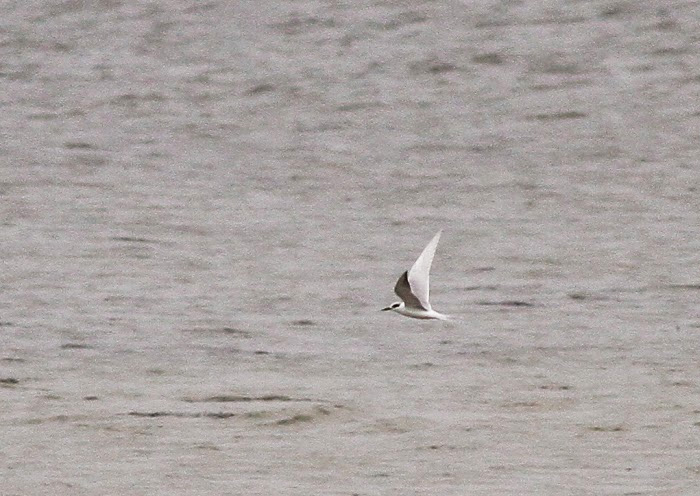
Two birds were in Limerick City on 24th (a long-returning adult and a new first-winter) and two more were at Cuskinny Marsh (Co. Cork) on 30th while single adults were noted along the Liffey in Dublin on 23rd, at Drogedha (Co. Louth) and Cobh (Co. Cork) on 24th, Bray (Co. Wicklow) on 26th (with a new second-winter there on 31st and a near-adult alongside them on 2nd), Tramore (Co. Waterford) to 30th with a second for Louth, the regular adult remaining at Crusietown in to the New Year.
The 2nd saw news of single adults in Wexford town and also still at Portrush (Co. Antrim) with a second-winter at Lough Leane (Co. Kerry). Further new adults appeared on the border of Clare and Galway, at Corranroo and on the mud at Glanmire (Co. Cork) on 4th, while the GAA pitch in Kilkee hosted a fresh first-winter on 5th.
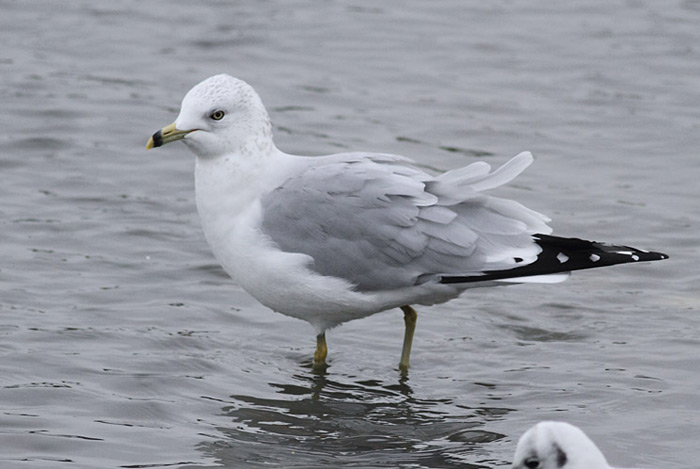
The Highland Ringo remained at Dingwall throughout the holidays and on to 6th, as did the Hampshire old-timer was at Gosport’s Walpole Park throughout, (perhaps dropping in to Blashford Lakes HWT on 23rd-24th and 30th-6th, though it could well be a fresh one...), while further adults were at Chew Valley Lake (Somerset) on 23rd, at the Passage House Inn, Teignmouth (Devon) for half an hour on the afternoon of 26th, in the roost on Strathclyde Loch (Clyde) on 27th-5th, again in west Wales, at Llys-y-fran Reservoir on 28th, 30th and 3rd, on Cornwall’s Gannel Estuary on 1st and Heltson Boating Lake from 3rd when a 15 minute adult dropped on to South Huish Marsh (Devon)
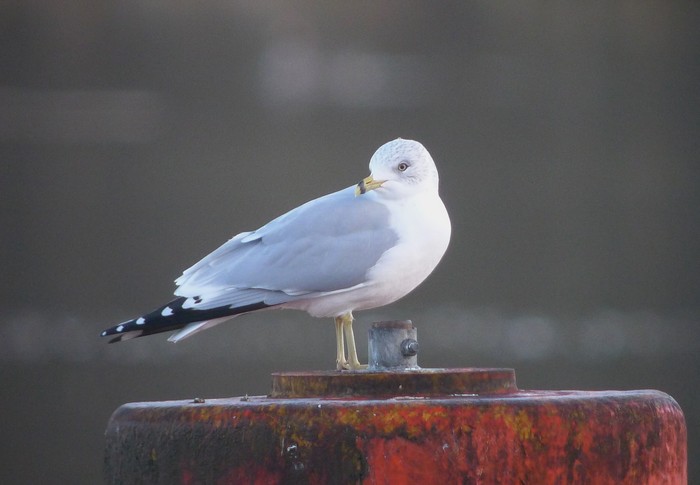
New Ring-billed Gull stock appeared in the form of a first-winter at Swanpool, Falmouth (Cornwall) on 30th.
On the coast of south Devon, the adult Bonaparte’s Gull that headed past Dawlish Warren on 27th and then again 29th-1st before being noted over the water at Exmouth on 3rd. In Scotland, the adult reappeared at Loch Gilp (Argyll & Bute) on 30th-31st. In Ireland, the second-winter Laughing Gull reamined at Ballycotton (Co. Cork) to 2nd at least - this bird was first seen on January 18th 2014, remaining there until March 13th and reappeared (as a first-summer, after a visit to Wicklow) on June 27th where it has been recorded every month until now.
Also in Ireland, an Azorean Yellow-legged Gull was reported at Knightstown, on Valentia Island (Co. Kerry) on 31st.
The turn towards some wintery weather saw a slight upturn in numbers of white-winged gulls compared to recent weeks. By the end of January 6th, a minimum 80 Glaucous Gulls had been reported, including 20+ on assorted Scottish islands, including eight or nine around Shetland and eight on the Outer Hebrides. There were up to 15 for northeast England (with two reported together at Hartlepool fish quay on 29th) and half a dozen for the northwest, while Cornwall and Scilly managed a further six between them and Ireland scored around 14. Some eight singles were seen in East Anglia (maybe four or five in Cambridgeshire and two each for Norfolk and Suffolk) with six in the Midlands (three on Leicestershire’s Albert Lake on 30th and two in Derbyshire with one for Staffordshire) with three or four singles in southeast England (two in Kent and one in Essex and Hampshire) too. Wales managed one or two as well, seen in Pembrokeshire on 3rd-4th.
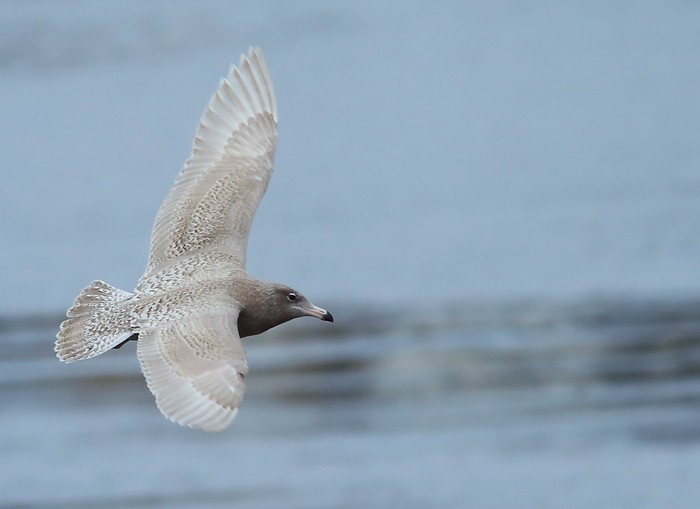
Iceland Gulls nudged up to around 75 birds by close of play on 2nd - at least 22 were widely spread across Scotland, from Shetland to Lothian - with as many as 15 birds in northeast England, including up to four or five around West Yorkshire’s reservoirs and dumps, with four at Northumberland’s North Shields Docks on 6th. Two or three more were noted in Lancashire and singles or twos were seen in Pembrokeshire, Staffordshire, Cheshire, Nottinghamshire, Warwickshire, West Midlands, Cambridgeshire, London and Scilly, while around 18 were recorded in Ireland too, in Antrim (up to four there), Cork, Kerry, Galway, Sligo and Donegal (up to seven or eight there through the fortnight, including four at Killybegs on 2nd).
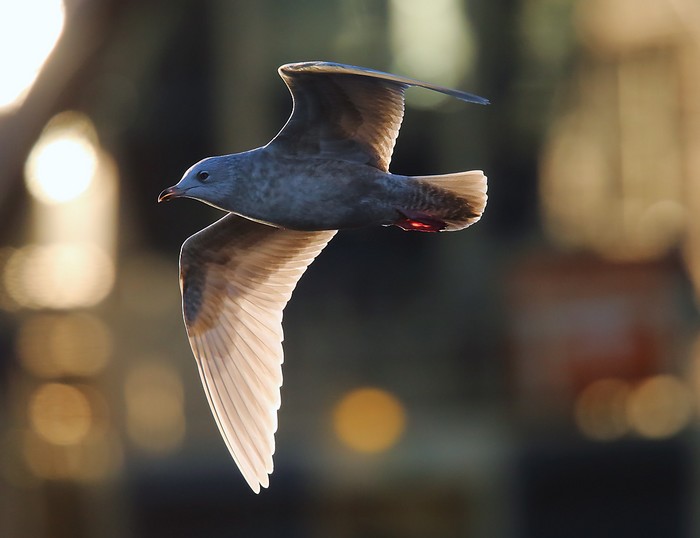
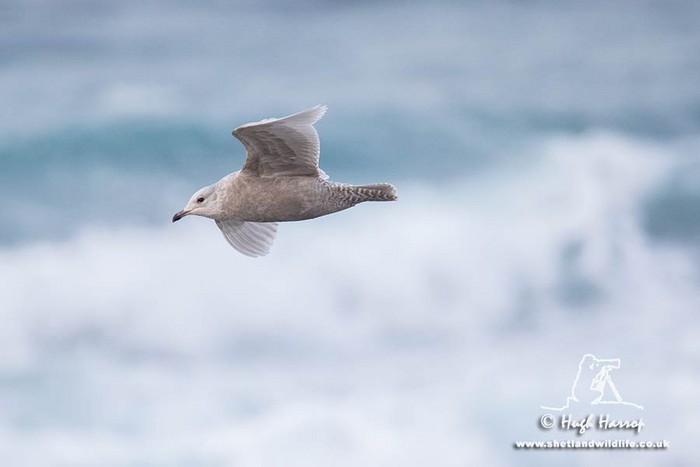
There were six Kumlien’s Gulls noted through the fortnight - the juvenile remained at Scatness, on Mainland Shetland to 5th, with another bird-of-the-year was on Loch Caolisport (Argyll & Bute) on 30th with the third, fourth and fifth all being found on New Year’s Eve - at Greencastle (Co. Donegal), back on Shetland, in Lerwick and also at Ormsary (Argyll & Bute) too (where something rather better was lurking...). The sixth Kumlien’s of the fortnight, an adult, was located in the Wheldrake Ings roost on 2nd.
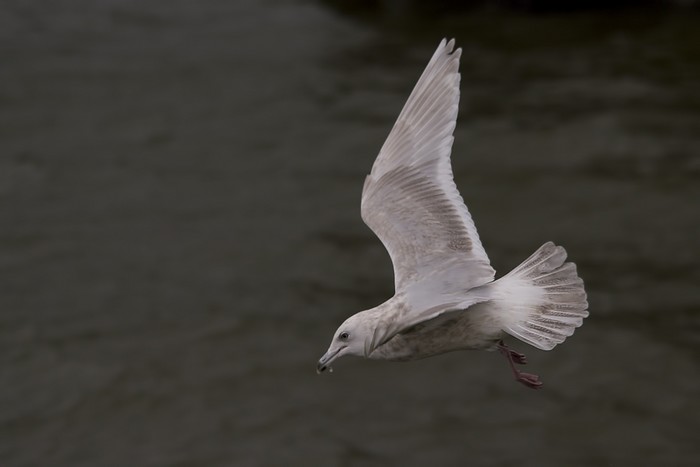
Yep, best of the bunch was (thayeri and spotty-beasts aside...) the presumed first-winter American Herring Gull at Ormsary - found on 29th and still present on 2nd, this one follows swiftly on from the two youngsters in the county in February and March 2014.
As numerous roundups have reported lately, the place to be to see Rough-legged Buzzards was most certainly Norfolk, with the Burnham Overy area being pretty much a guaranteed spot to see the popular wintering species, with birds seen daily across the whole holiday period, with three present on 28th. Two more were seen in Norfolk on the same date, heading west over Titchwell RSPB with another still at Halvergate Marshes through to New Year’s Eve.
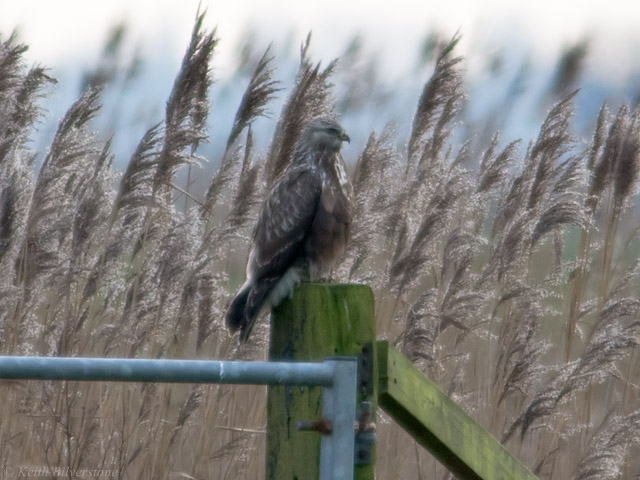
New Norfolk birds were seen over South Wootton on Christmas Day and at Watlington and Little Barningham on 2nd, while singles were again at Welney WWT on 29th and Breydon Water on 1st. East Anglia’s only other individual remained at Holme Fen NNR (Cambridgeshire) to January 5th.
In southeast England, singles remained at Jevington (East Sussex) to 5th and on Wallasea Island (Essex) to 2nd, with a second Essex Rough-leg being seen at South Woodham Ferrers on 28th and one was also reported from Bedgebury (Kent) on 3rd. The northeast of England saw birds remain at Heckington (Lincolnshire) and near Bridlington (East Yorkshire), to 29th and 4th at least, with a second in East Yorkshire on 30th too. Back in Lincolnshire, a bird that flew in off the sea at Gibraltar Point NNR at dusk on 28th may well have been the mobile bird seen at Titchwell earlier in the day.
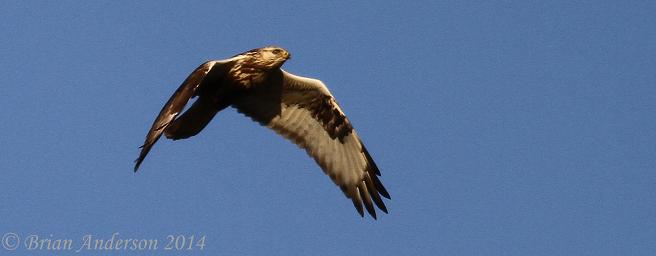
The final bird noted was the Scottish bird that lingered at Mennock Pass (Dumfries & Galloway) to 5th. Also in the same county, the colour-ringed juvenile White-tailed Eagle remained around the West Freugh Airfield to 27th (having first been noted there on 21st and is, presumably, the same bird that was seen at Wigtown on 20th).
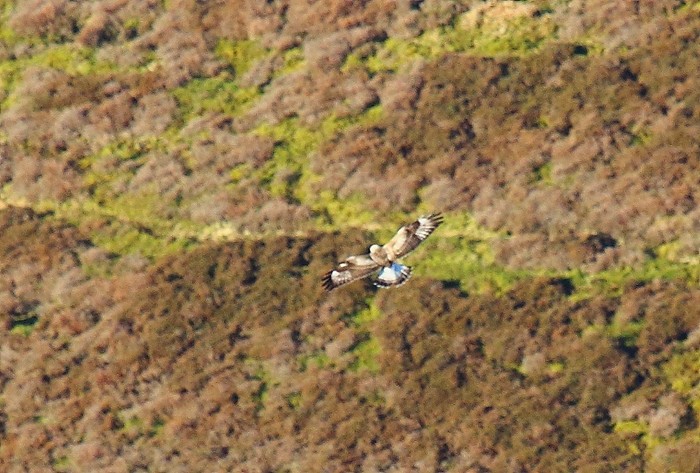
Further to the northeast, news of a brief fly-through white Gyrfalcon over Glen Ey (Aberdeenshire) on 29th with a second white bird seen for 20 minutes on Dumbarton Castle (Clyde) during the late morning of 2nd, appearing a mile away at West Ferry a couple of hours later - potentially only the second-ever for the county, the first was seen at Loch Lomond in November 1960 (when it was still Dunbartonshire). The third ermine-clad assassin was noted at Ardclach (Moray) on 5th - a county which als has few accepted records to date, only three in all, the last of which was on November 24th 1977.
In Devon, the three Penduline Tits were noted on a couple of occasions over the Christmas - two of the trio were at Bowling Green Marsh RSPB on 24th and then all three were again at Darts Farm, near Topsham between 27th-30th and 1st-6th, albeit infrequently.
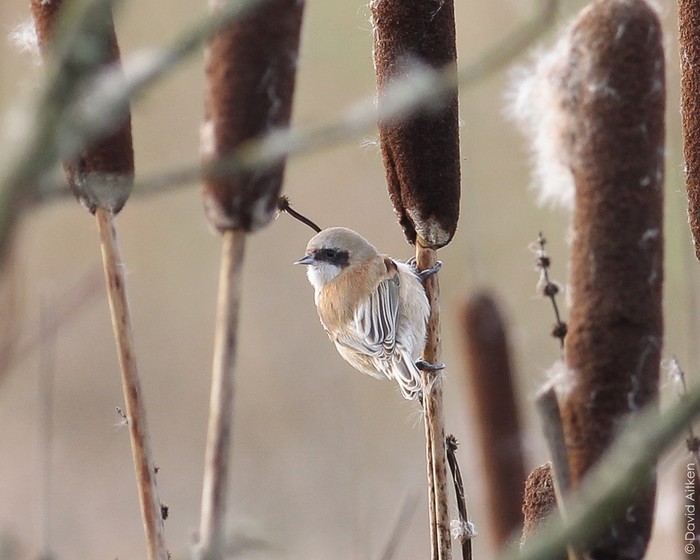
Arguably more impressive still than the Devon threesome was the excellent find of a lone Penduline Tit at Priory County Park (Bedfordshire) on 28th, a bird that lingered to 30th - the third record for the inland Home County but the second for the site (the first spent a day there on September 18th 1991, with two one-day birds at Marston Vale Country Park on November 10th 2012 being the only other record for Bedfordshire.
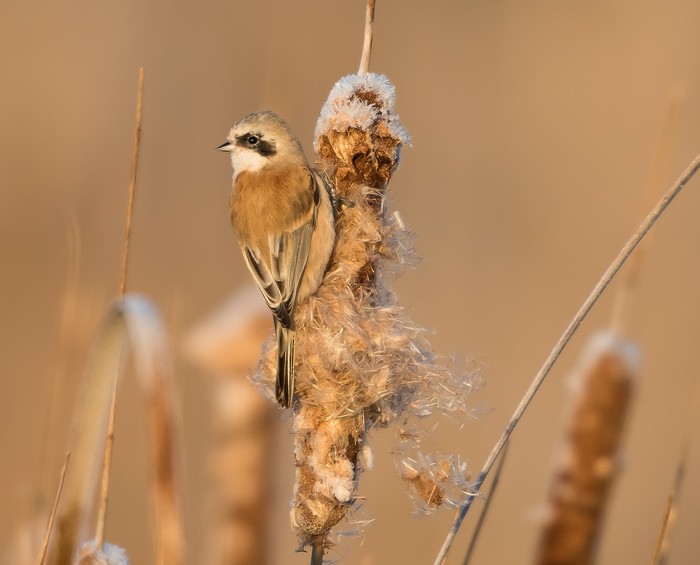
Portland’s Barred Warbler seems to have gone missing post Boxing Day while the 11 Yellow-browed Warblers were all noted in southwest England - on Christmas Day, one was found in Bridport (Dorset), while the 28th saw wintering birds emerge on St. Mary’s (Scilly) and Loe Pool, Helston (Cornwall) and on 30th, up to three bird was found on The Lizard (including two at Coverack) and one was seen at Colyton (Devon). Devon’s next newbie was found on New Year’s Eve, this one in Plymouth. Ever-present almost throughout the period were the individuals at Beesands and Broadsands (Devon) and Penryn (Cornwall).
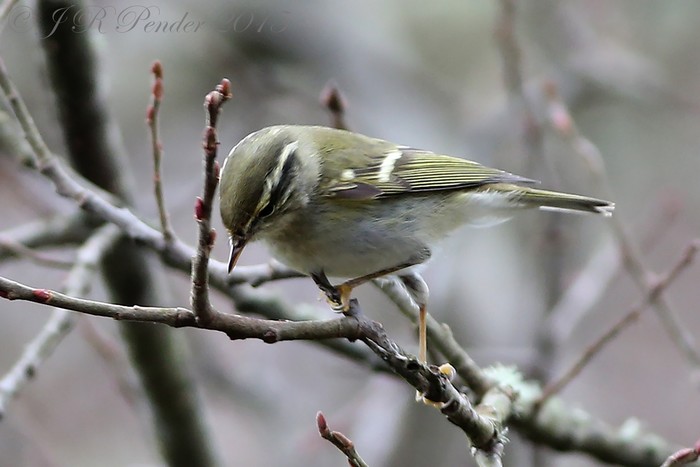
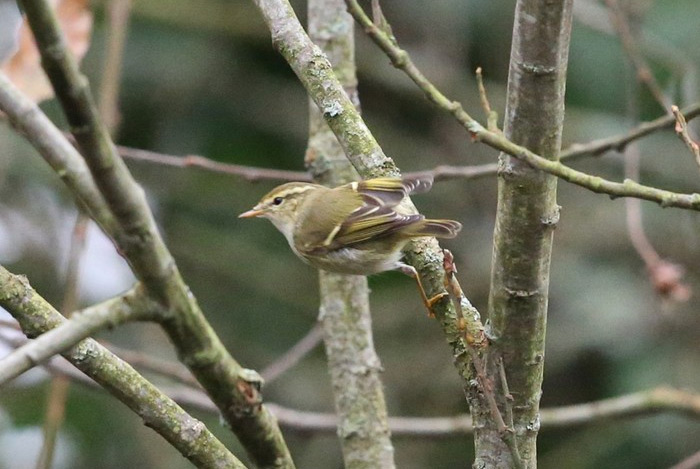
More of a surprise in the wing-barred warbler stakes, the New Year’s Day Pallas’s Warbler found at Dungeness - closely matching the same site’s New Year discovery of a Hume’s Yellow-browed Warbler this time last year…
Lacking wingbars but also coming as a little bit of a New Year surprise was the discovery of a wintering Dusky Warbler at Chichester GPs (West Sussex) on 5th - the first county record since one at Climping in October 2005. This year’s bird showed through to the following day.
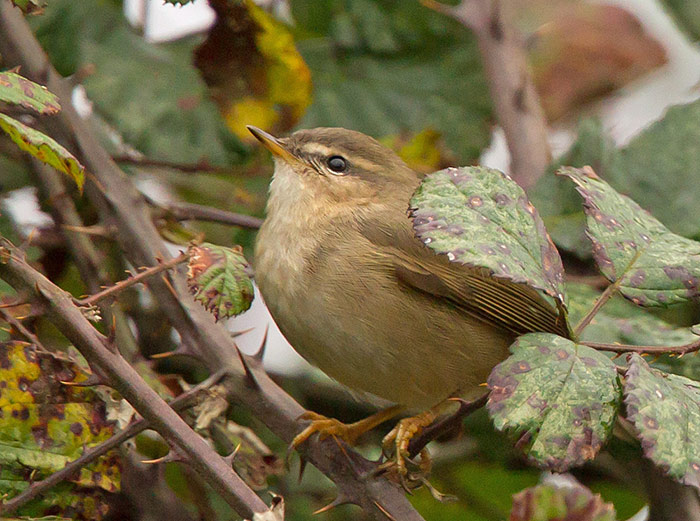
There was another decent showing of wintering Richard’s Pipits over the past fortnight, eight in all, including twos still at Cloughton Wyke (North Yorkshire) and Stolford (Somerset) (with one at the former, and both at the latter to 4th). Recent leftovers also lingered at Horsey (Norfolk) to 24th, at Redcliff Point, near Osmington (Dorset) to 5th and Horse Eye Level (East Sussex) intermittently to 6th, while a new arrival was reported from Galley Head (Co. Cork) on 27th.
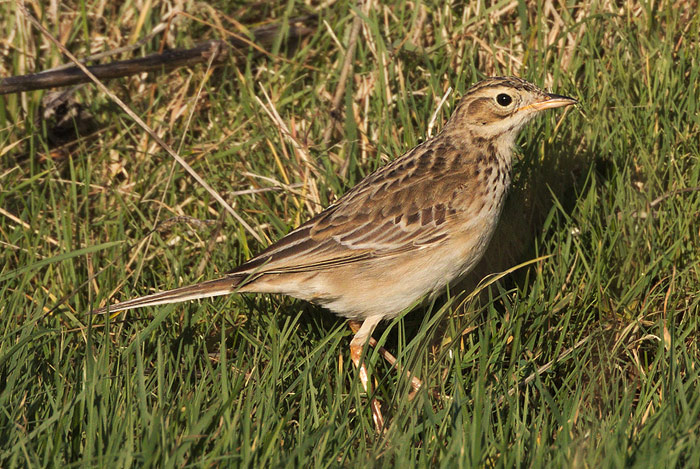
Further atypical overwintering goodies included the Hoopoe that was seen again in gardens near Dawlish Warren NNR (Devon) on Christmas Eve and again on January 2nd and the elusive adult Rose-coloured Starling that remained in the urban gardens of Bishopton, Bristol, to December 29th.
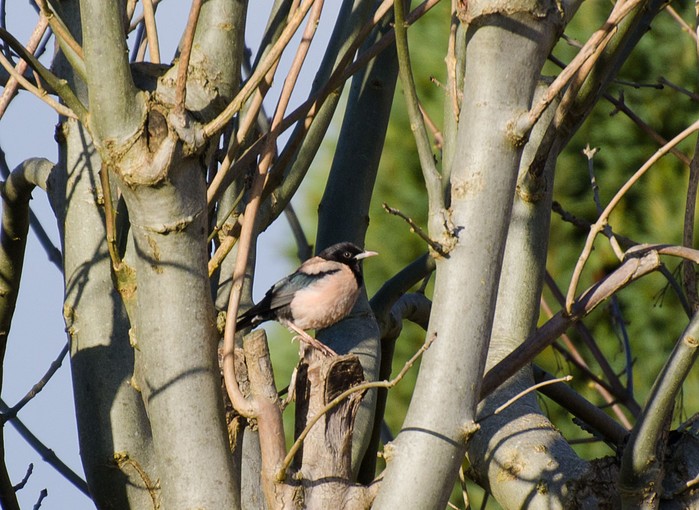
Great Grey Shrikes were a popular festive diversion for many, at least 32 birds noted in 21 counties or more as the shutters came down on 6th. In northwestern England, two birds remained in Lancashire - at Grindleton on 27th-5th and Lytham Moss to 6th and the wintering individual remained at Dalton Crag (Cumbria) to 5th while the northeast included two birds in South Yorkshire, at Thornseat Delf on 23rd-24th and Thorne Moors NNR on 26th-3rd, with further singles in the Langdale Forest (North Yorkshire) to 29th, near Gainsborough (Lincolnshire) to 3rd and at West Harford Farm (Northumberland) to 6th.
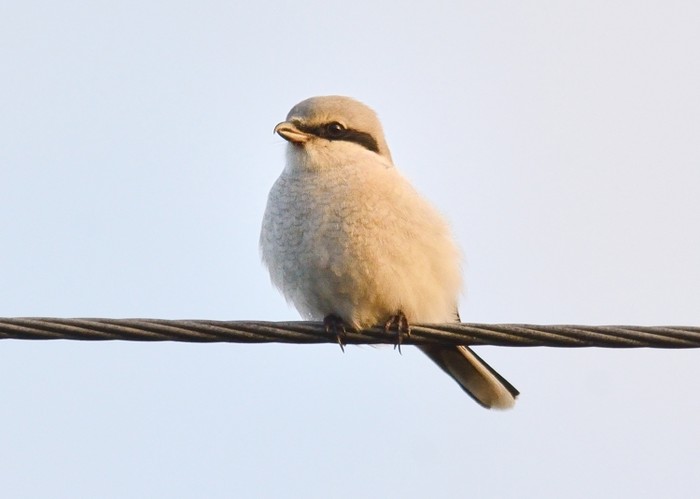
The Midlands saw singles noted at Rainworth (Nottinghamshire) and, in the south of the region, still at Crabtree Hill, Forest of Dean (Gloucestershire), both on 26th, with a second in Gloucestershire, at Great Barrington on 2nd. Two were noted in Derbyshire, at Church Wilne on 28th-5th and at Beeley Moor to 5th with another on the border with Leicestershire, at Shardlow on 4th. Northamptonshire scored one on 2nd, seen at Deenethrope, a bird which lingered to 6th. In Norfolk, a Great Grey Shrike continued its winter hols on Roydon Common NNR throughout the whole fortnight whilst on the Suffolk birder, another remained around Santon Downham to 5th at least.
Eight or nine singles were seen in five southeastern counties of England: at Broomy Plain (Hampshire) on 24th-29th and, in the same county, still at Bransbury Common on 29th-4th, Milkham Inclosure on 31st; at Frensham (Surrey) on 27th; at Ledburn (Buckinghamshire) from 30th and on border with Bedfordshire, near Leighton Buzzard to 5th; on Thursley Common (Surrey) to 4th and still at Iping Common (West Sussex), in the Ashdown Forest (East Sussex) and Chilham (Kent) through to the turn of the New Year. The south west of England was represented by a lone bird on Devon’s Aylesbeare Common RSPB to 4th.
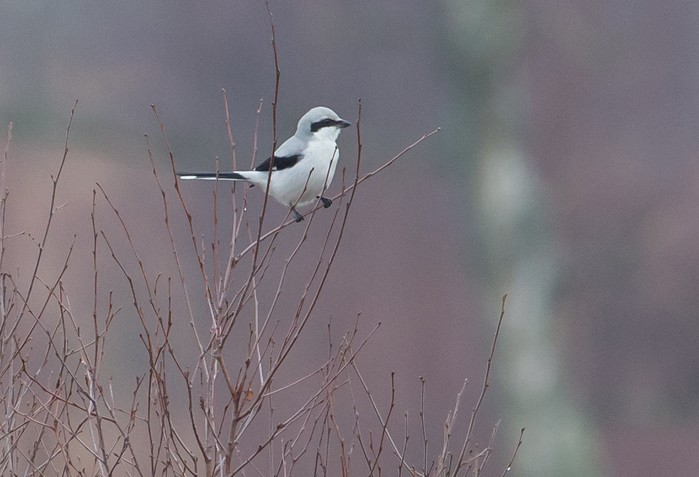
Rounding things off, perhaps as many as four birds for Glamorgan - at Abercarn on 24th, Llwyn-on Reservoir on 26th, Parkmill on 4th-5th and Fairwood Common from 5th - and two n Powys, at Trecastle on 30th and at Lake Vyrnwy RSPB on 6th.
Despite the coldish snap that pitched up around Christmas, it didn’t really bring anything too spectacular where numbers of Waxwings were concerned - flocks of 20 in Belfast (Co. Antrim) on 23rd and Witnesham (Suffolk) on 30th and up to 40 in Edinburgh (Lothian), also on 30th, being the only double figure tallies of note. Four birds were at Wallsend (Northumberland) on 24th and singles in Angus, Cleveland, Lincolnshire, Norfolk and Hertfordshire were some of the only others reported in another lean winter for these glorious berry-biffers.
There we are then, 2015 off and running and although this is traditionally one of the quietest times of the year, there’s a couple of things that although highly unlikely to do the business in the week ahead, are somewhat thought-provoking…
First up (and selected as a potential two or three days in advance of the smaller relatives…s’true! Honest…) the still-much “needed” by many Great Bustard.
Quite when the next “tickable” examples of this supreme vagrant will appear here is one of the big questions for many birders who weren’t birding/listing/born (!) when the last accepted set of birds were seen - up to five in Suffolk in January to March 1987 (with three well-twitched ones at Theberton in February) and two in south Norfolk, at New Buckenham from February 7th-10th of the same year.
The early months of 1987 were fiercely cold and much of the continent was solid ice - presumably pushing the birds to East Anglia. Since then we’ve had numerous freezing winter, likewise continental Europe but the Bustards have stopped coming.
The 28 years that have elapsed have given barely a hint of a wild Great Bustard and the continuing success of the regularly roaming released bird originating from “secret sites” in Wiltshire has clouded the issue considerably. The past decade has seen many reports from Somerset and Dorset (including a very recent one on January 5th), along with other known released individuals in Gloucestershire, Hampshire, Oxfordshire, Devon, Berkshire and, most recently, Alderney in the Channel Islands.
One record stands out - the photographed bird in Suffolk, at Lavenham on April 18th 2013. Where did that come from? Released birds wander and make sea-crossings to boot, but none have travelled as far east as that one. Could it have been the real deal? And was it the same bird reported a few days later in Essex?
For the nouveau-twitcher, they have to hope it wasn’t “real” but equally the lame hope that, at some point, the Wiltshire birds generational thing will kick in and make them “tickable” is also not a way to avail yourself of a simply stunning bird.
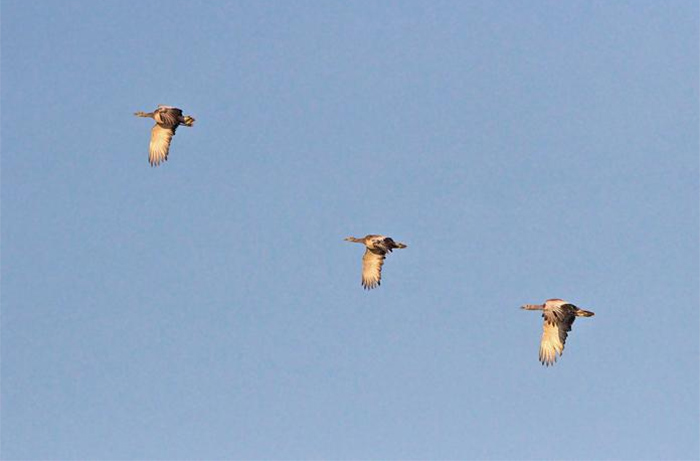
The week ahead has three historic records of four Great Bustards- one was seen in Hampshire on January 12th 1910, two were at St. Margaret’s Bay (Kent) on January 11th 1970 with January 7th 1978 seeing the arrival of the infamous young male at St. Nicholas-at-Wade - a bird who’s four-month suppression caused major ructions at the time, check out some old copies of British Birds for a few passionate “letters to the editors” on the subject.
Remarkably (in a twist of cinematic-like fate worthy of his film-making namesake could only dream of) Alan Parker, the finder of East Sussex’s Little Bustard was also the finder of Kent’s most recent Great Bustard, on December 29th 1981 -33 years and a day between two truly outstanding finds - finds that confirm that no lack of Commitment in the field goes unrewarded because, no matter how many times you may hit The Wall, there’ll be some birding Fame out there somewhere…
Species two seems almost as unlikely to make a quick reappearance - Bald Eagle remains a monster vagrant here, with only two accepted records to date, both of those from Ireland. The first was a juvenile shot in County Fermanagh on January 11th 1973 and the skin was placed in to the collection of the Ulster Museum, where it was labelled as a White-tailed Eagle. The body was re-examined in 1995 and the correct identification came to light.
The second Irish vagrant record was the knackered juvenile found at Ballymaceillgot, near Castle Island, in County Kerry in November 1987. A tired and tame bird it was thought initially to be a Golden Eagle and then a White-tailed Eagle.Caught in an exhausted state sometime in the middle of the month, the bird was photographed by Richard T. Mills and a note about it then appeared in an Irish newspaper. The article prompted Killian Mullarney to head to Kerry on November 25th where he re-identified the bird as a Bald Eagle. After a few weeks in care in Ireland, the bird was transported back to the USA and released successfully.
There’s one other record worth a mention - the adult seen over Llyn Coron, on Anglesey on October 17th 1978 which has long been held to have been “ok”. The bird headed west over the site in the late morning, followed by a flock of grumpy corvids. The Eagle then landed, bathed at the lakeside and preened for three-quarters of an hour before departing, never to be seen again…
If either of a Bald Eagle or Great Bustard rocks up between now and next week, I’m off to do the Lottery and wait for the millions to roll in…
Mark Golley
07 Jan 2015
Thanks to this week's round-up sponsors - Oriole Birding
 |
|
||||
 |
|
|
|
||
|
|
|
|
|
||
|
|
|
||||
|
|
|
||||
Contributors websites
Check out our contributors website for more great photos and other news














